This hike and the breathtaking Western Ghats are akin to a pilgrimage, where Nature and reverence are inseparable
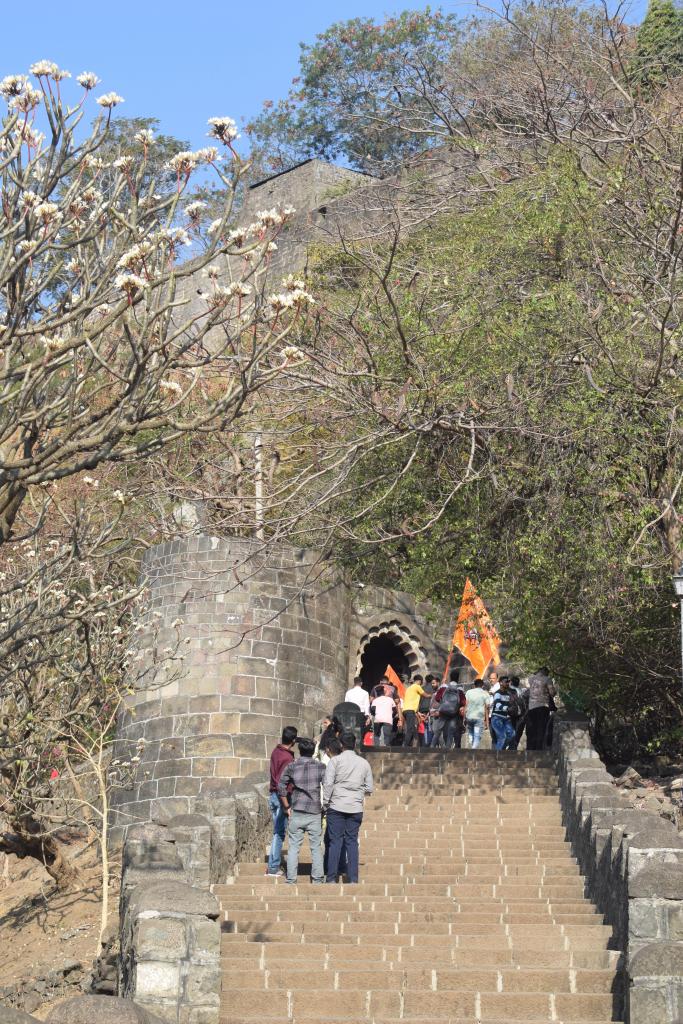
300-400 steps and more than an hour! My foggy brain jumpstarted; this wasn’t going to be an easy climb. We were in Junnar for the Hindavi Swarajya Mahotsav, hosted by Maharashtra Tourism. Celebrating the 394th birth anniversary of the great Maratha ruler, Chhatrapati Shivaji Maharaj, the three-day cultural bonanza was a lavish affair with heritage trails, farm tours, ziplining and more.
People from all over Maharashtra poured in to felicitate the birth of the revered ruler, an epitome of freedom, cultural identity and good governance. He was an astute ruler who used his coastal forts for trading and defence, and is hailed as the ‘Father of Indian Navy’.
As an Indian, I should be accustomed to the magnitude of celebrations across the country. But I wasn’t. The fervour was contagious, though the tradition a learning experience. Given the diversity of the sub-continent, this is normal. Each region is like a new discovery, and the birthplace of the revered Maratha king was a whole new world.
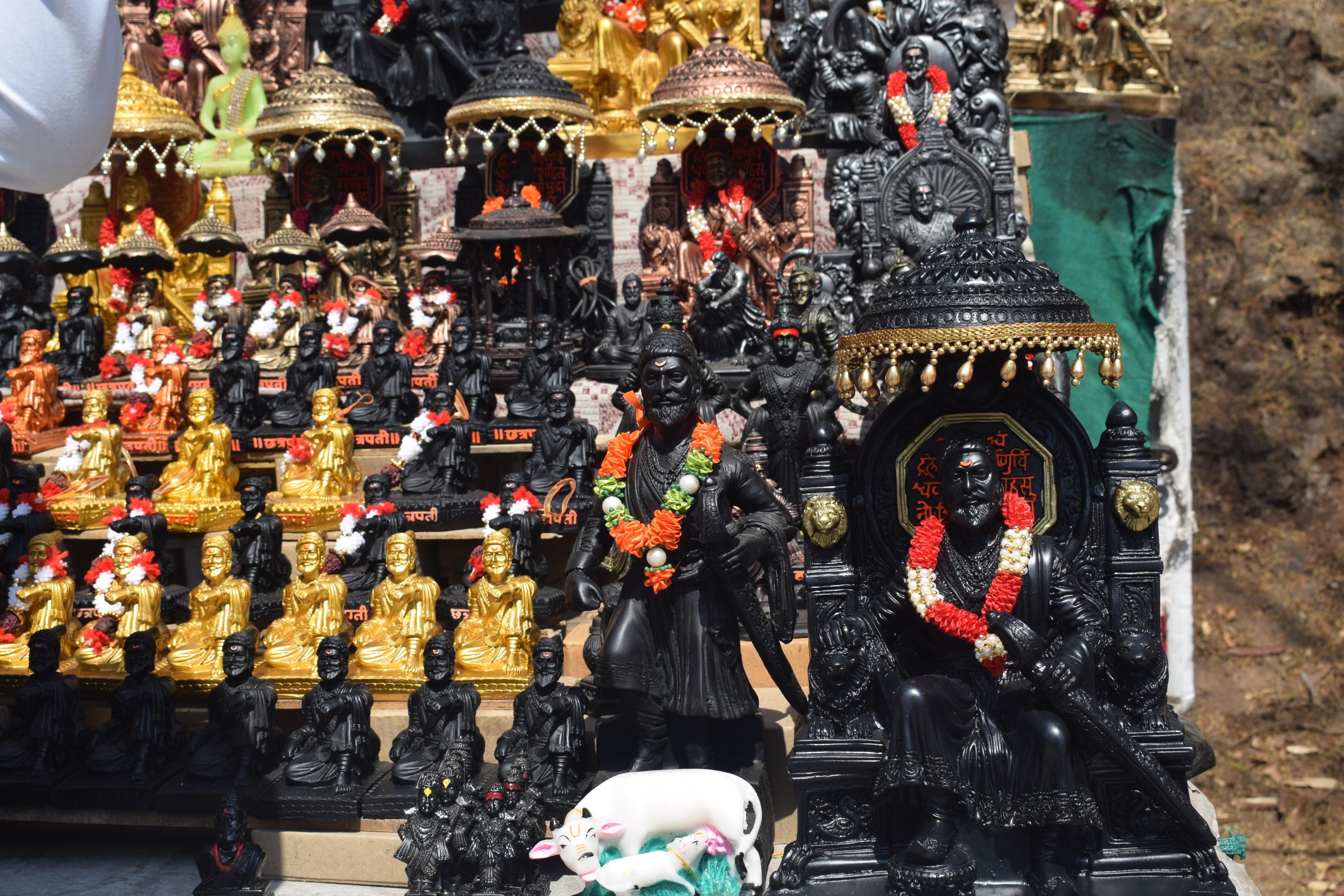
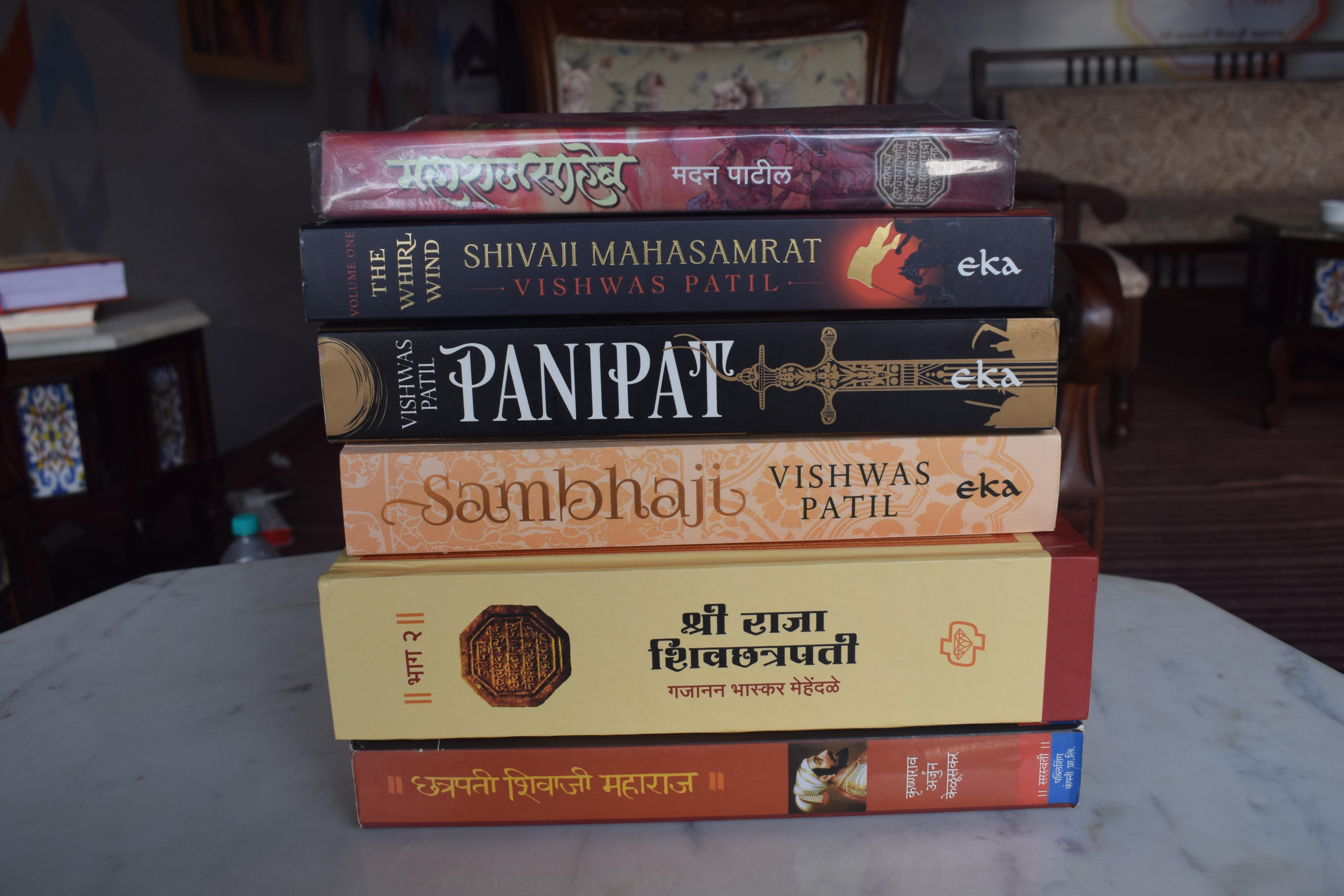
Who was Chhatrapati Shivaji Maharaj?
Born in the Bhonsle Maratha clan, Shivaji Maharaj carved out an empire from the declining Adilshahi sultanate of Bijapur. The government recognises his birthday as February 19, 1630, while some historians opine that he was born in April 1627. His birth anniversary is calculated as per the Hindu calendar annually, Tritiya tithi of Krishna paksha in Falgun.
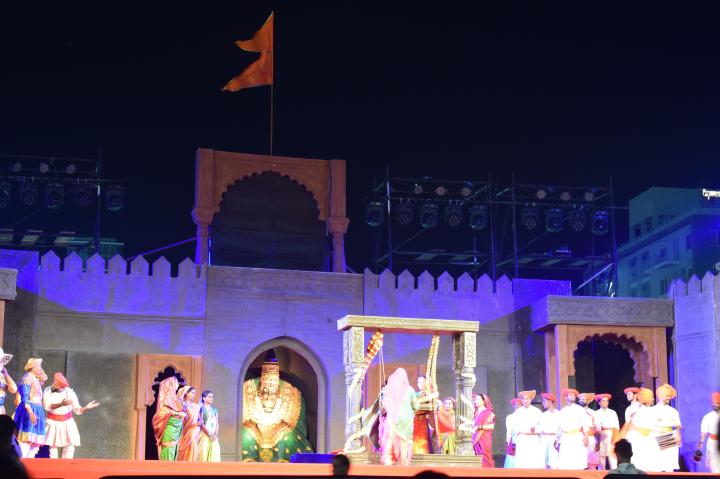
His father, Shahaji Raje, was a general in the Deccan Sultanates and his mother, Jijabai, was his driving force. After winning his first fort, Torna, at the age of 16, he won two more the year after that. He was formally crowned as Chhatrapati or monarch at Raigad in 1674.
A fearless warrior, he was known for his disciplined military and well-structured administrative abilities. He innovated the guerrilla warfare technique, leveraging strategic factors like geography, speed, surprise with pinpoint attacks to defeat his powerful enemies. He built and revived strategically located land and coastal forts. He kept the Mughals and other European powers at bay in his lifetime, passing away due an illness in April 1680.
He was instrumental in reviving Hindu traditions, revamping court conventions by the use of Marathi and Sanskrit, as opposed to Persian. Shivaji Maharaj’s legacy rose to full force during the Indian Independence Movement in the early 1900s. Tolerant of all religions, he holds the status of a deity among the people of Maharashtra, as I saw them carrying idols and worshipping him daily.
Shivneri Fort
Built atop a hill in Junnar, this fort is shaped like a shivalinga. The roots of Junnar go deep in time, back to the Satavahan era of the 1st century BC. This fort was on the ancient trading route between Desh and port city of Kalyan.
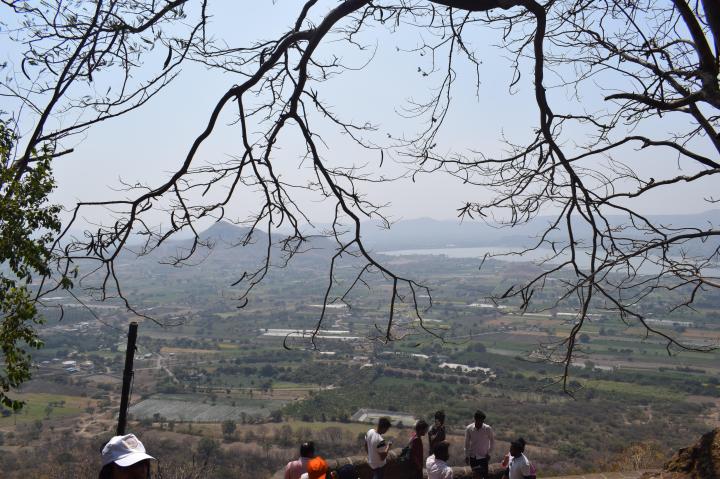
The city’s name, Shiv comes from the local deity Goddess Shivai, whose temple is located within the fort, and ‘neri’ means nagar or town in Marathi.
Beginning with the Yadava Dynasty, Shivneri was controlled in succession by Delhi Sultanate, Bahmani Sultanate, Ahmadnagar Sultanate, Maratha Empire, Mughal Empire, East India Company (1820–1858), the British (1858–1947), Dominion of India (1947–1950), until it became part of the state of Maharashtra in independent India.
Shivneri Fort came under the hold of Maratha chief Maloji Bhosale, Shivaji Maharaj’s grandfather, in 1595. Given the status of a noble by Bahadur Nizam Shah, the Ahmadnagar Sultan, Maloji got control of Shivneri and Chakan regions.
Born in this fort, Shivaji spent the first two years of his childhood here. He was named after Goddess Shivai, whom his mother worshipped during the pregnancy.
In 2021, Shivneri Fort was added to tentative list of UNESCO World Heritage sites as part of ‘Serial Nomination of Maratha Military Architecture in Maharashtra’.
The fort, under the aegis of the Maharashtra Forest Department, turned out to be a moderate yet long hike (a little more strenuous than the climb to Karla Caves near Lonavla).
The Hike
Had I gone to Shivneri at any other time of the year, I would have missed the deep reverence of the Hindavi Swarajya Mahotsav, though I would have still enjoyed the rugged magnificence of the Sahyadris.
Maharashtra Tourism gave us the provision of touring the region with ‘Junnar Tourism Destination Management Company’. This company was founded in January 2024 by a group of 10 natives who are keen on offering unique absorbing experiences. We got to experience the fort-cave-temple trails, farm tours and adventure activities with the native founders.
The Shivneri Fort heritage trail was conducted by Siddharth Kasbe, a history graduate and a journalist with Sakaal, the popular Marathi newspaper in Maharashtra. Like us, he was in no hurry, leading us slowly through the major landmarks to give us a peek into the life and times of the grand Maratha Empire.
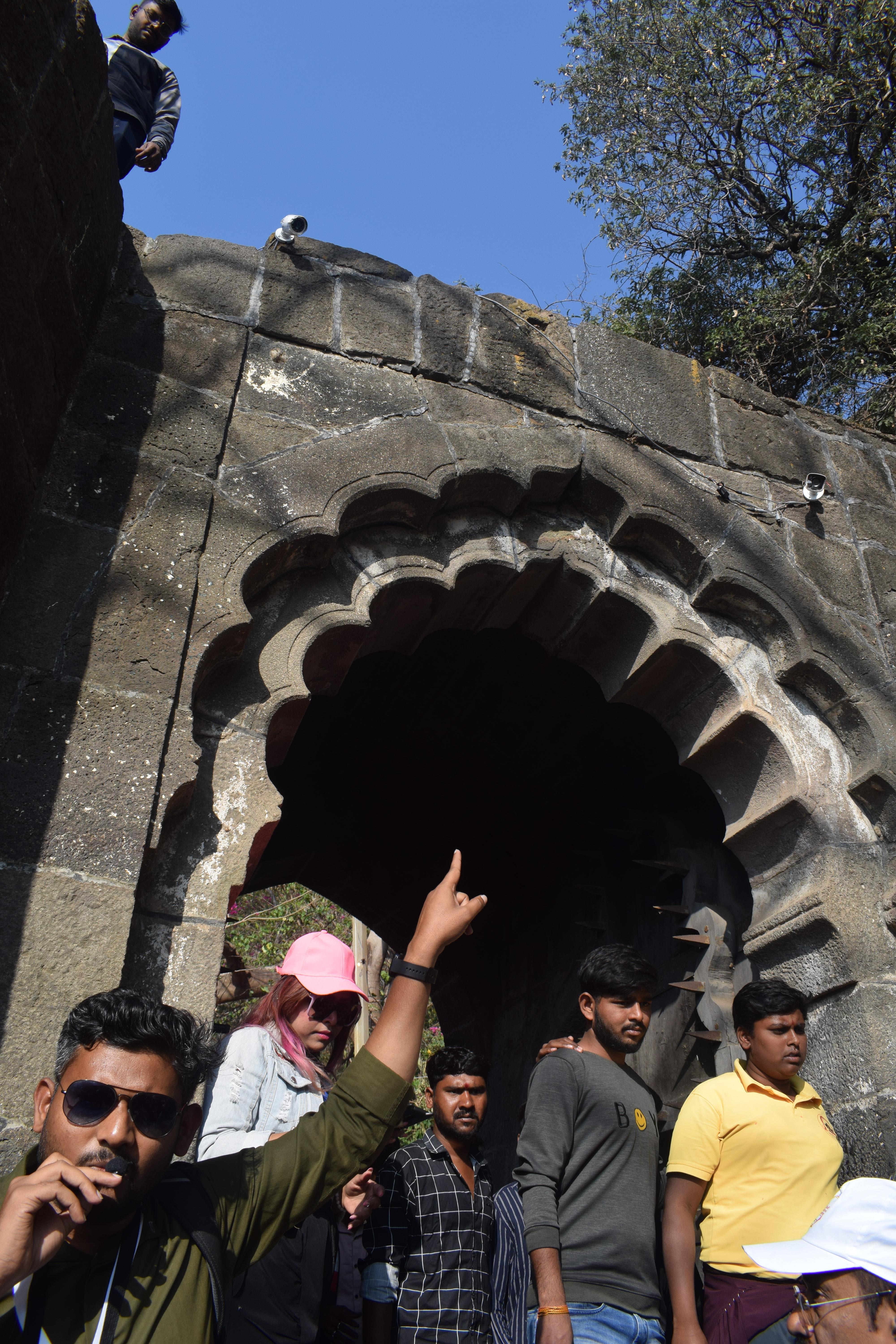
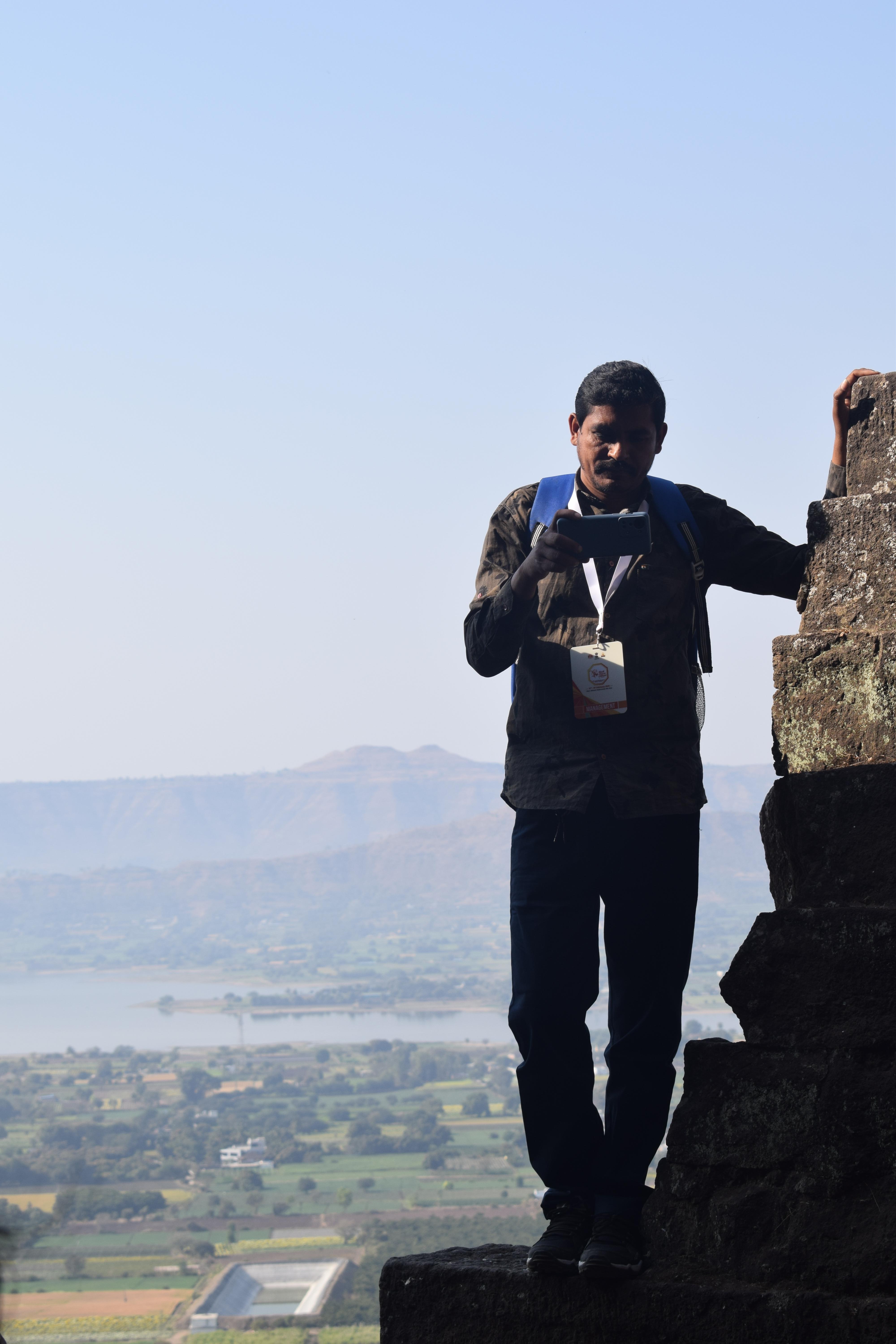
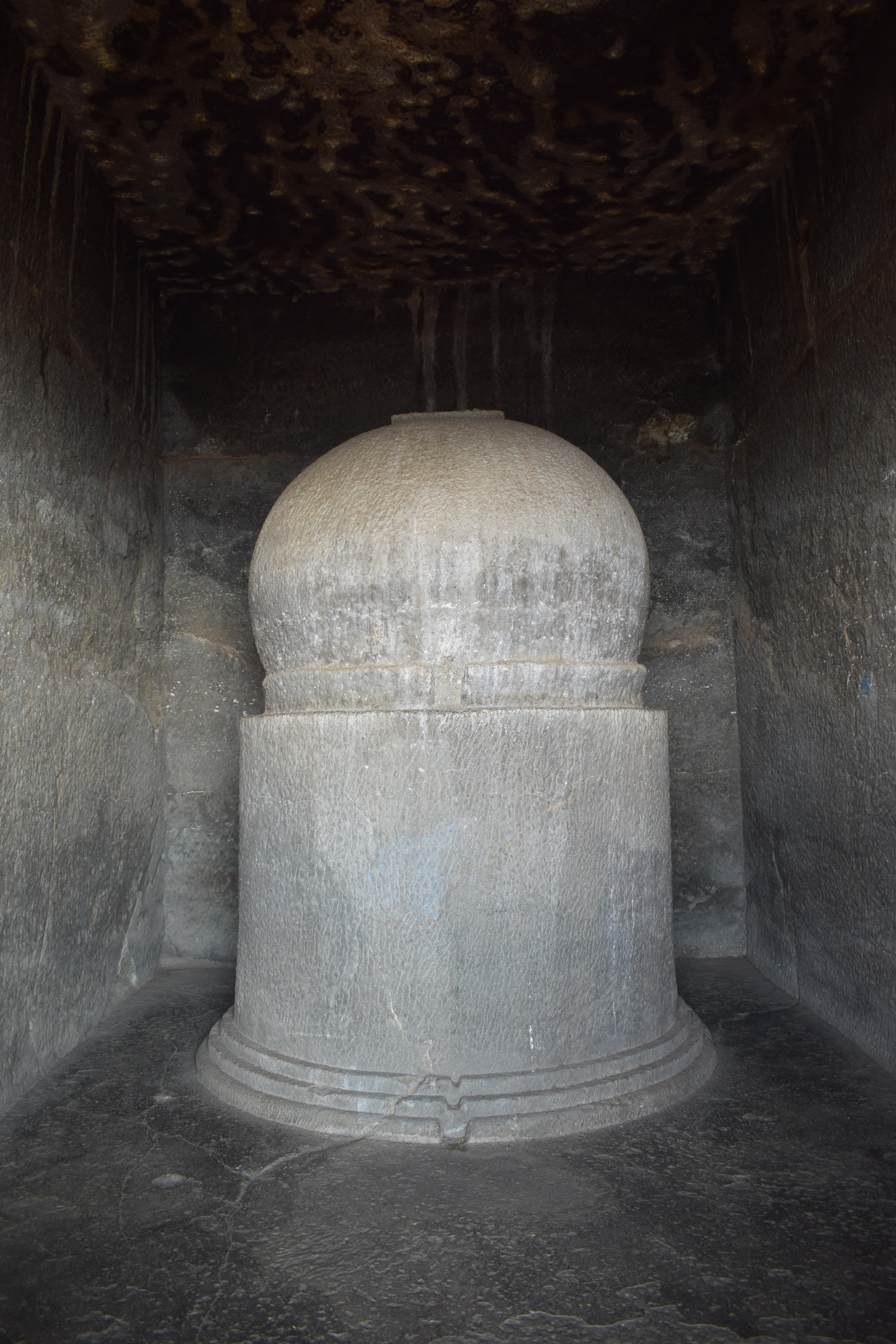
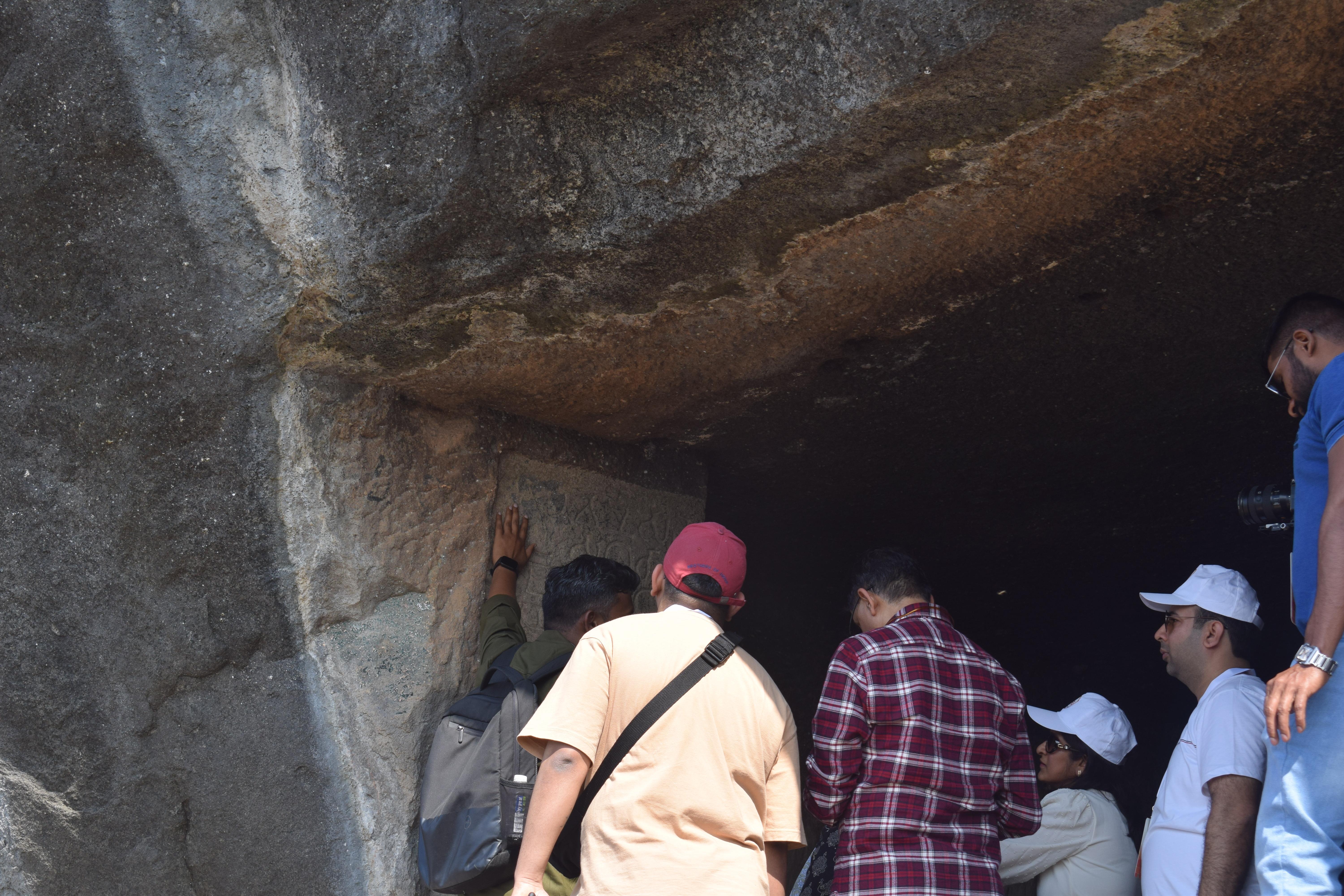
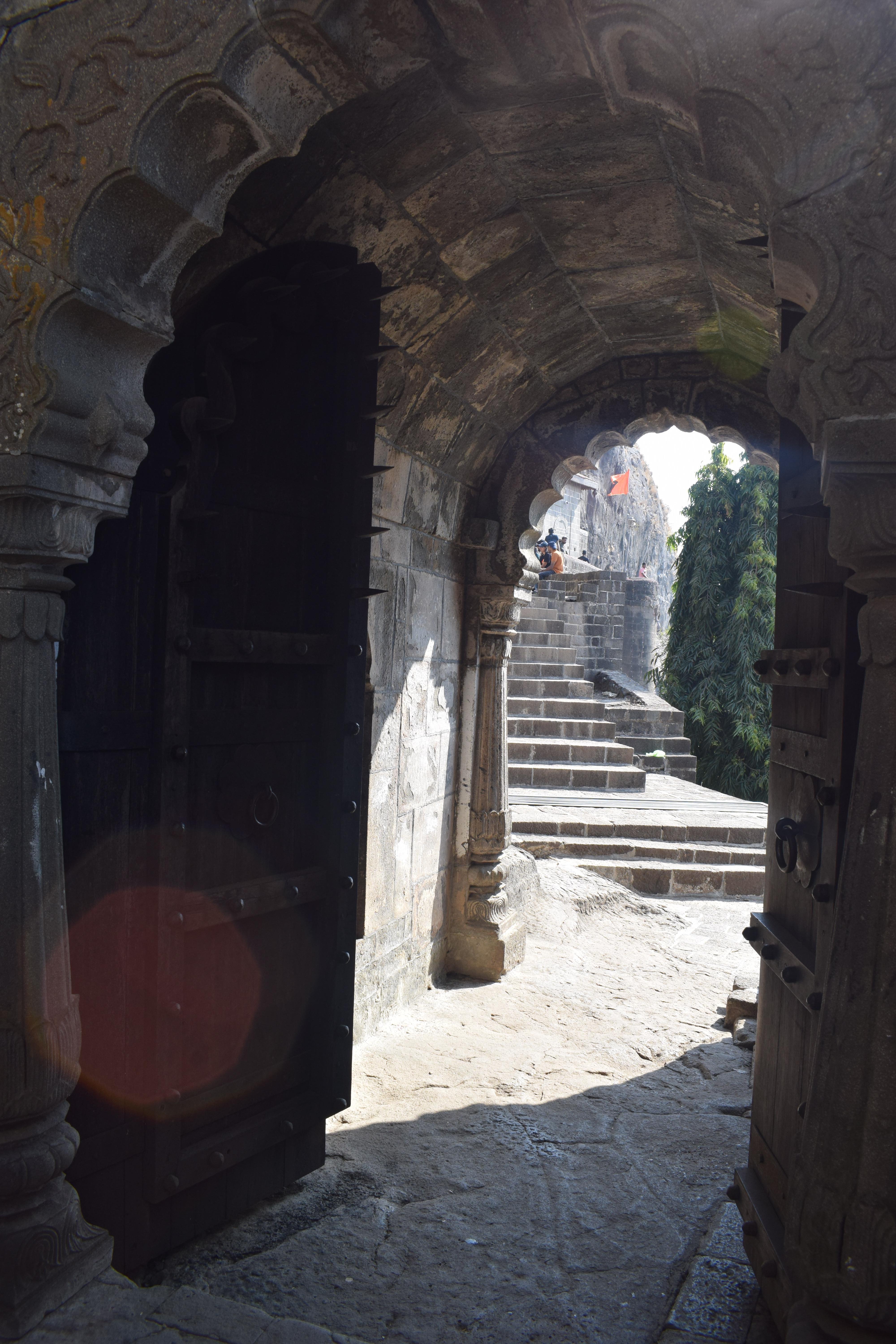
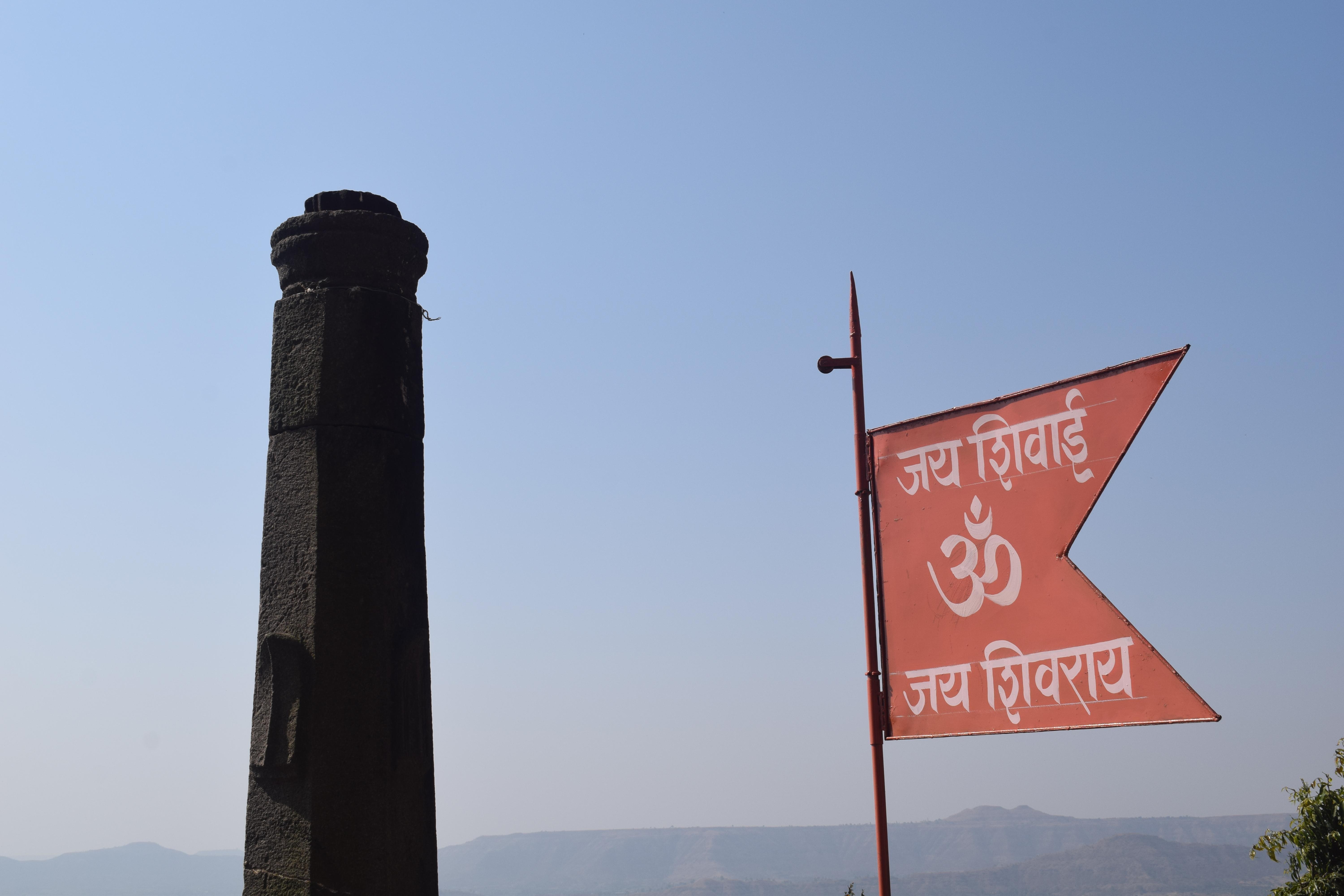
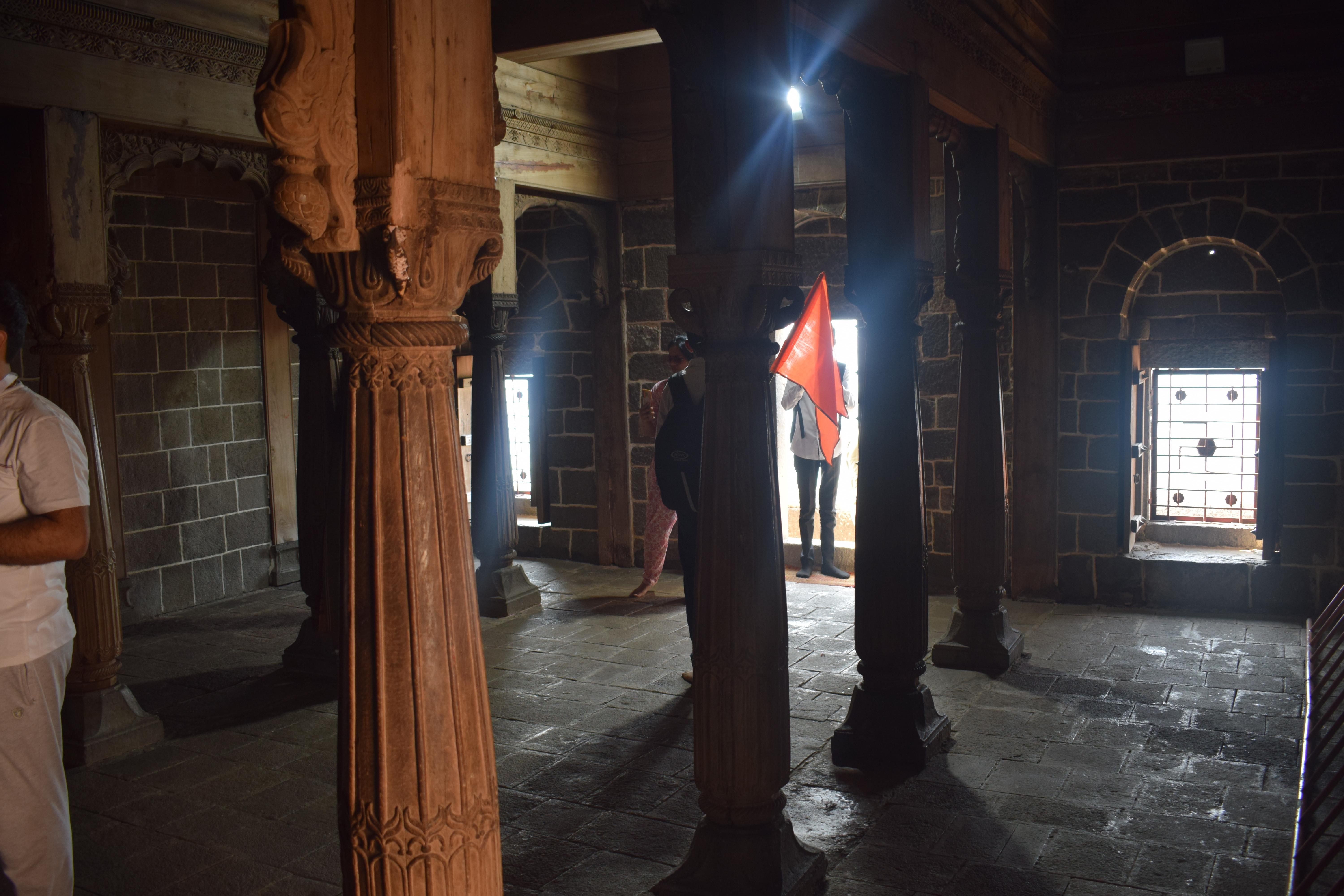
The important places of attraction were the Buddhist caves, Goddess Shivai Temple, Ambar Khana, two-storied birthplace, Badami Talao, mosque, two springs—Ganga and Yamuna, Kadelot Kada and a new temple housing the statues of Shivaji Maharaj and his mother, Jijabai.
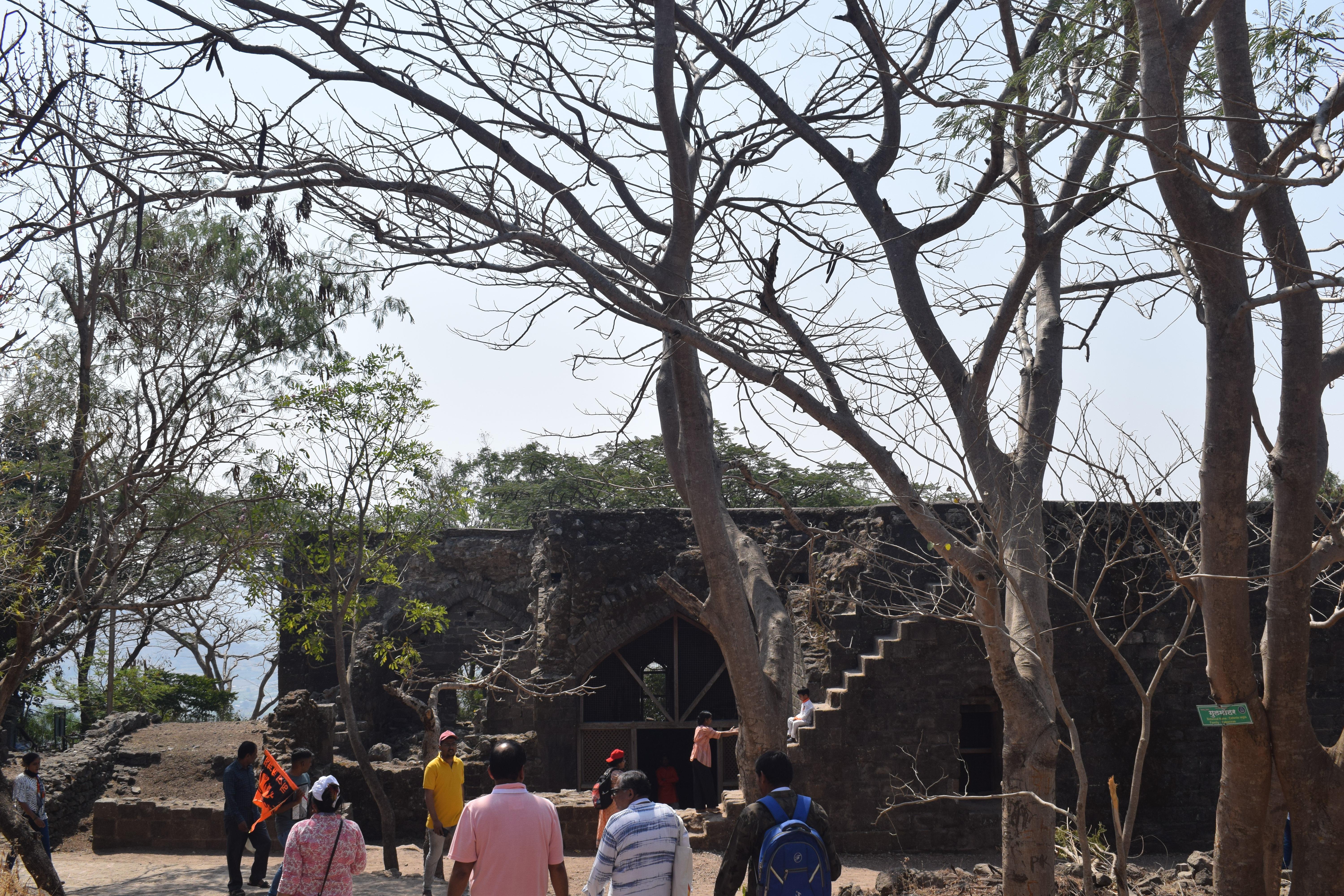
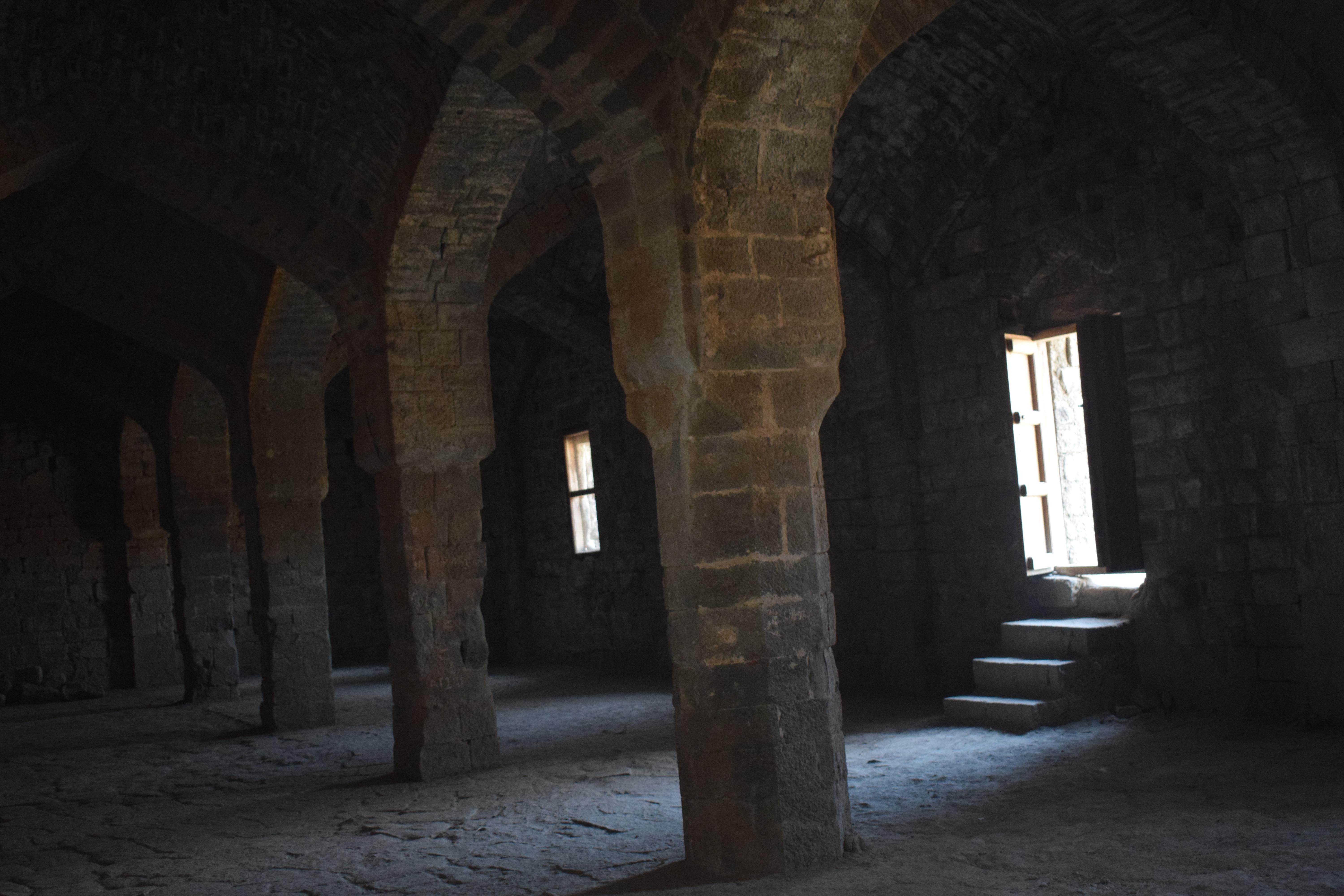
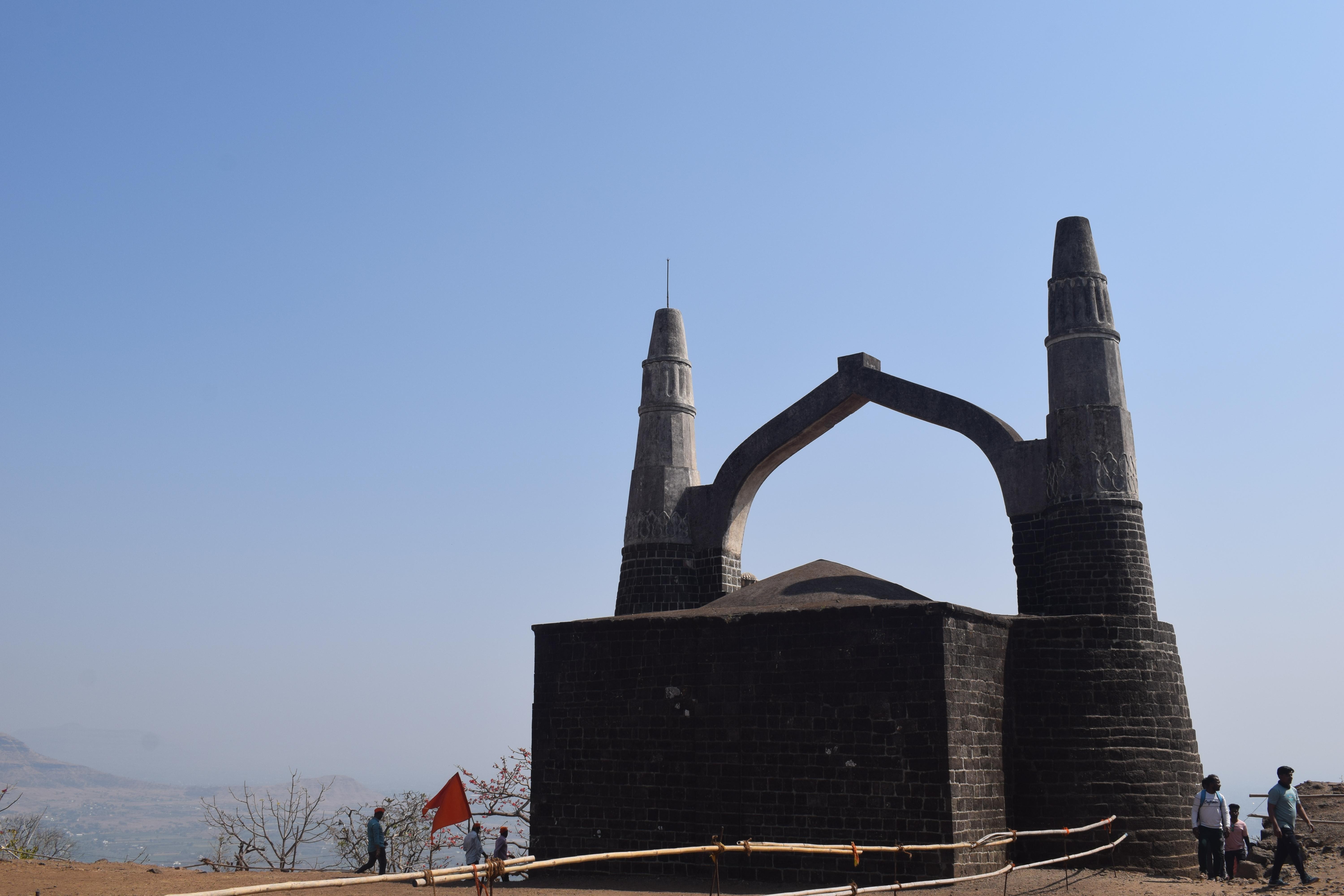
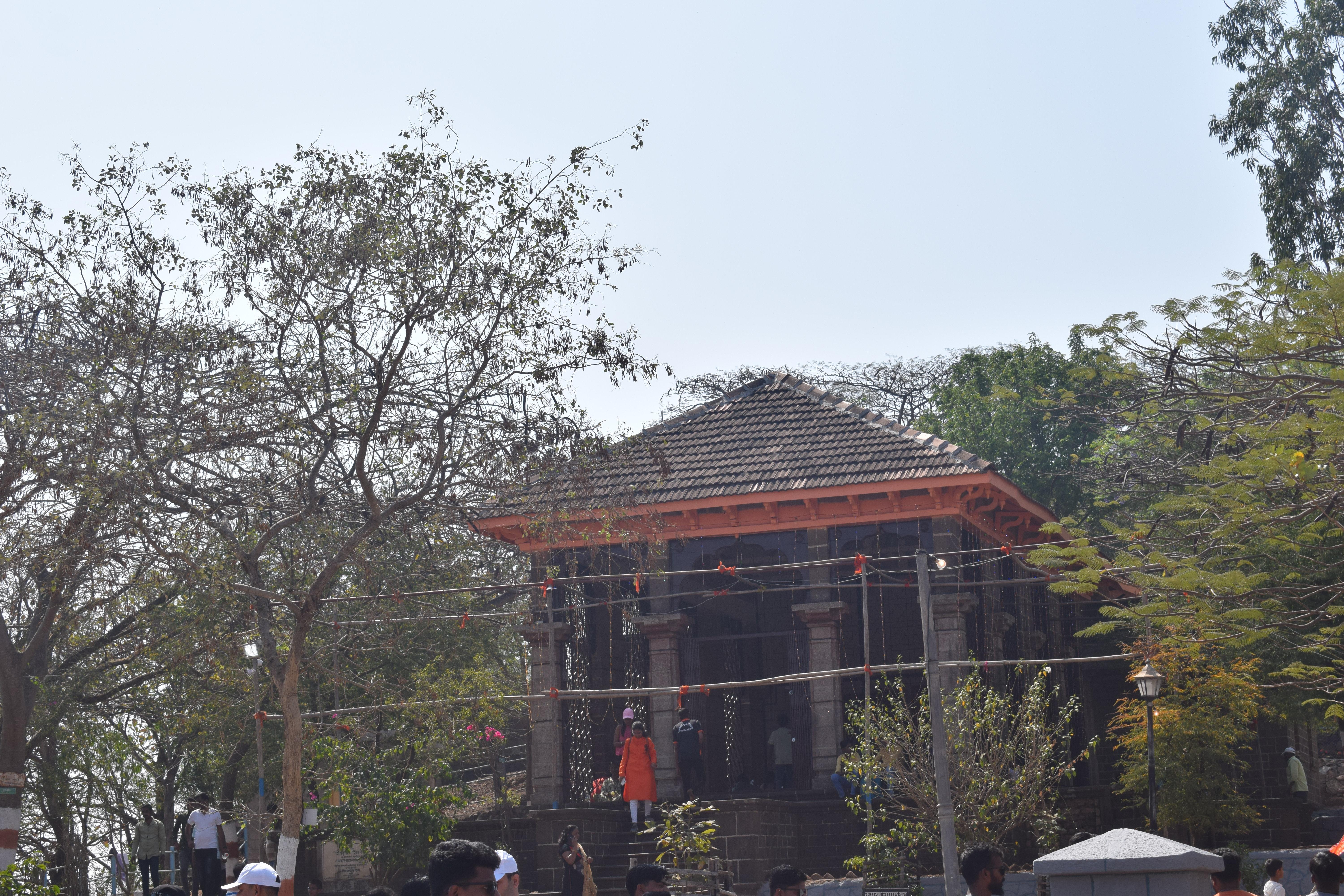
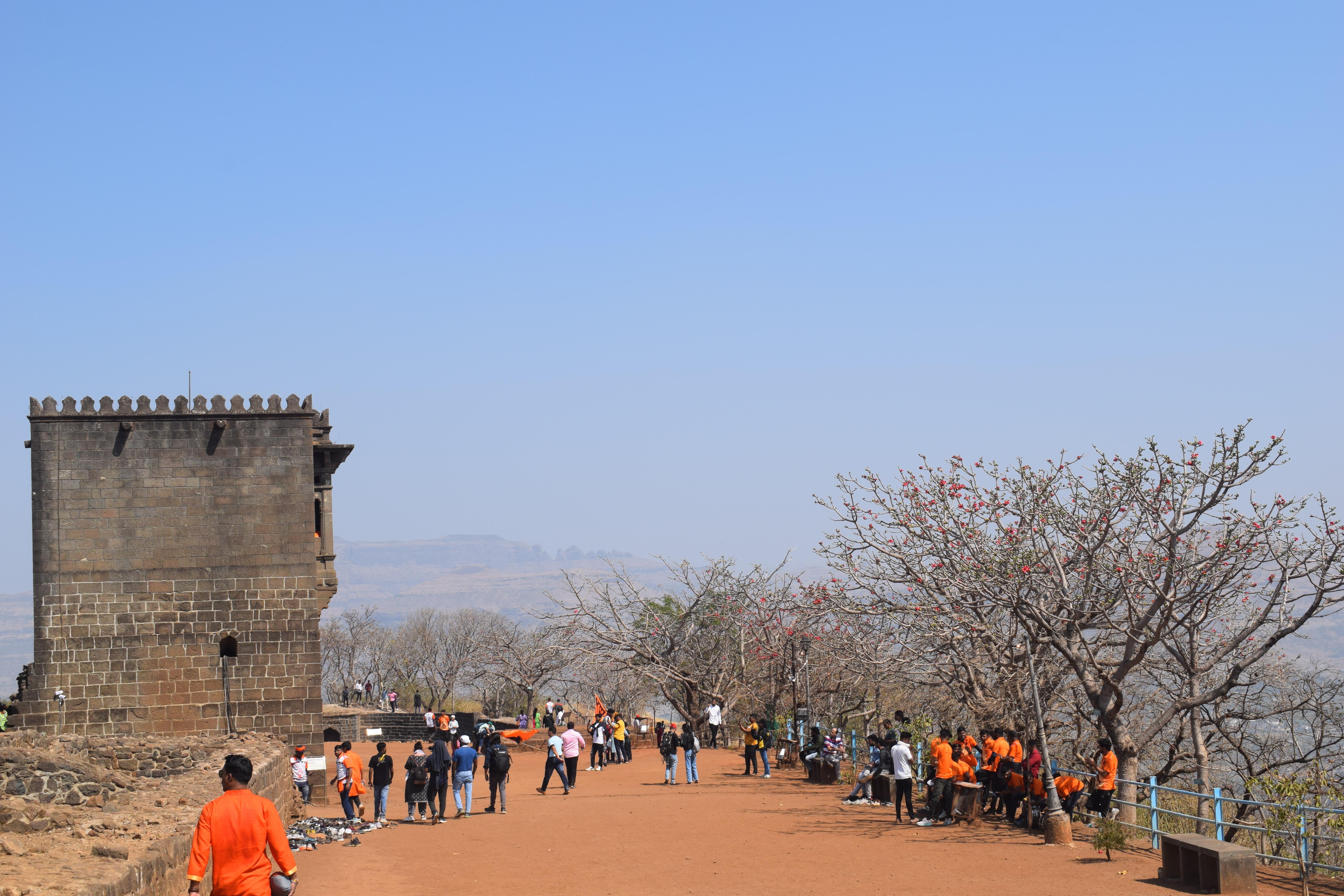
There are seven doors that lead to the birthplace of Shivaji Maharaj. These seven doors are: Maha Darwaza, Parvangicha (permission) Darwaza, Hatti Darwaza, Peer Darwaza, Shipai (soldier) Darwaza, Phatak Darwaza, Kulambkat Darwaza. The doors are important, as they were the stop points for the invaders.
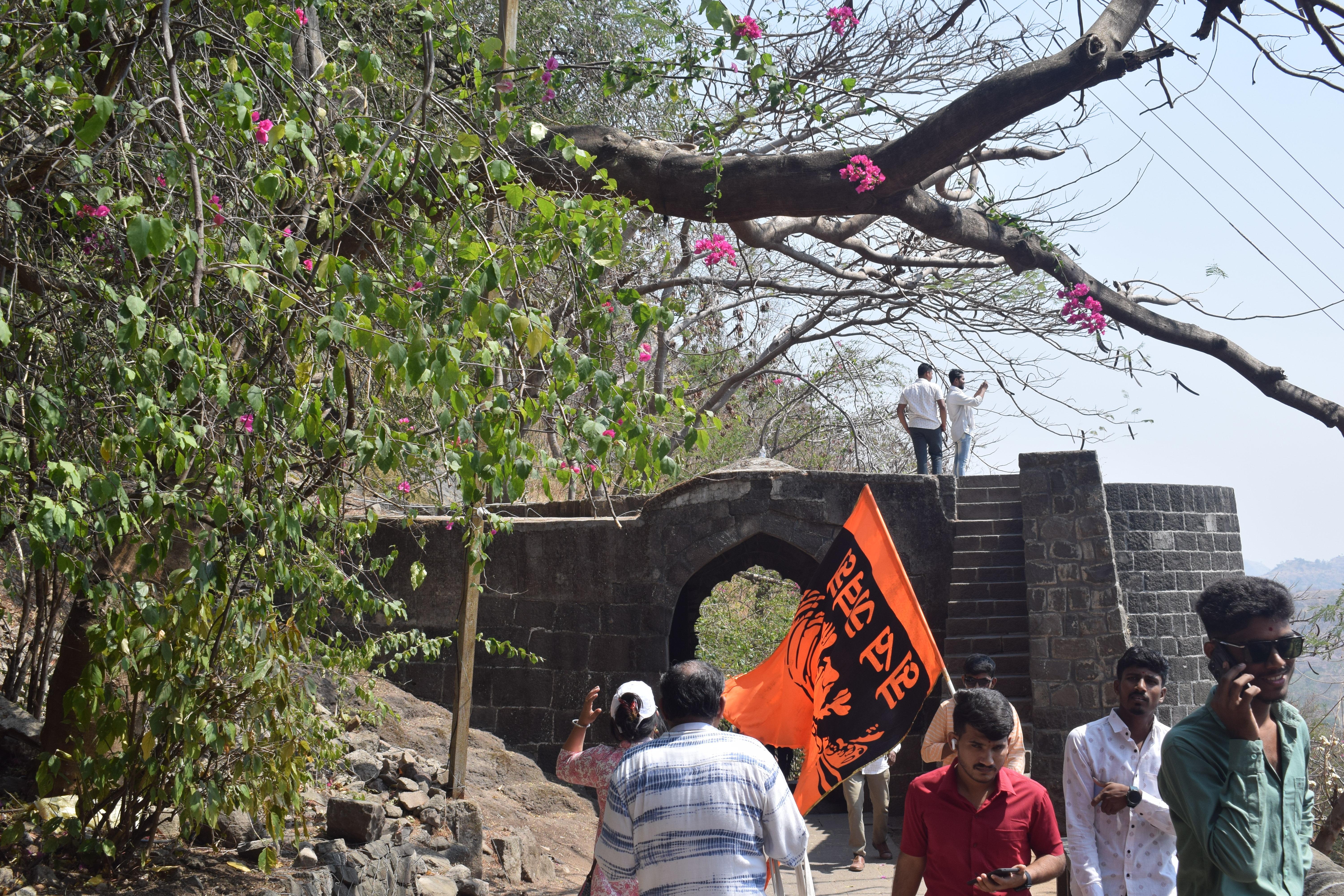

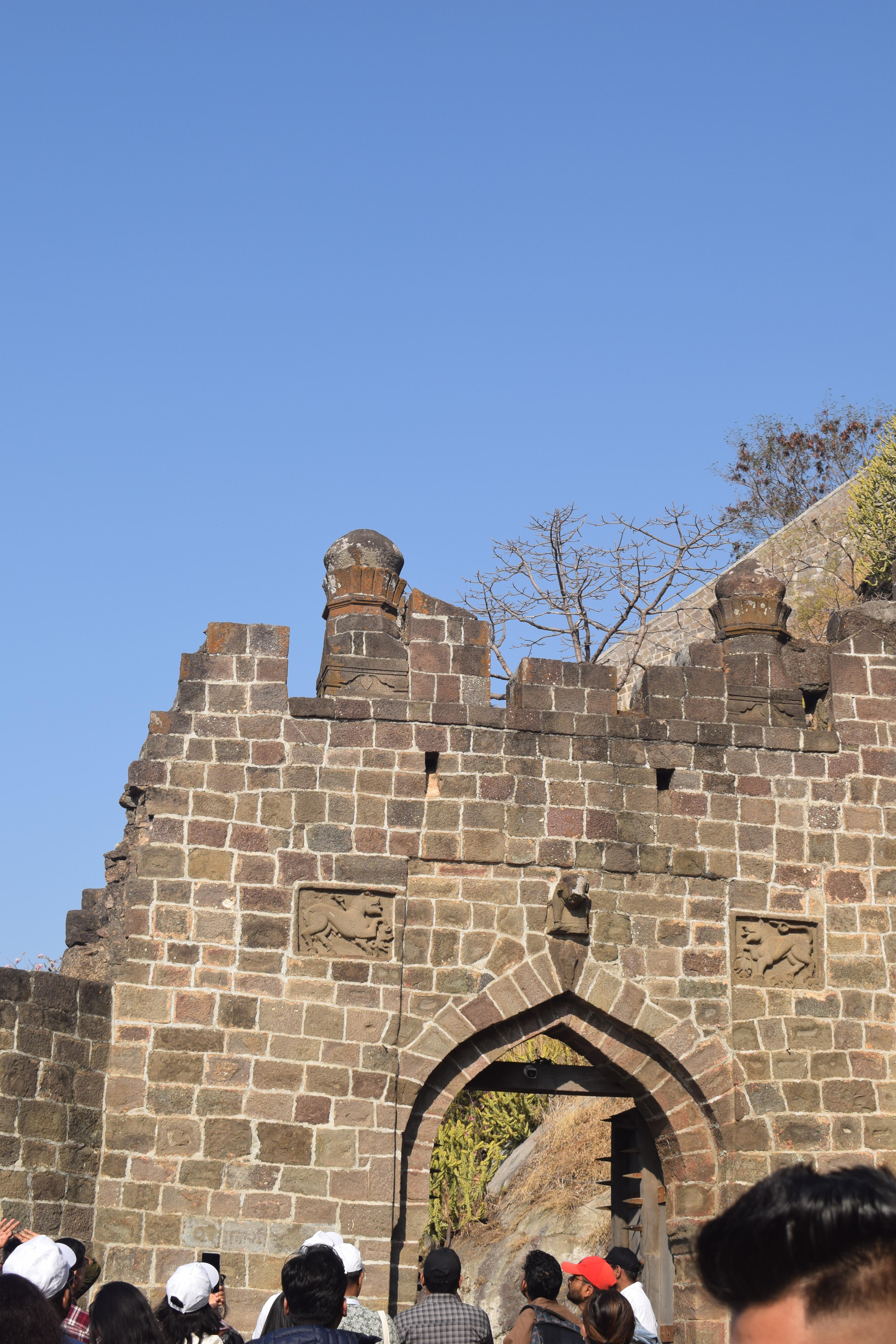
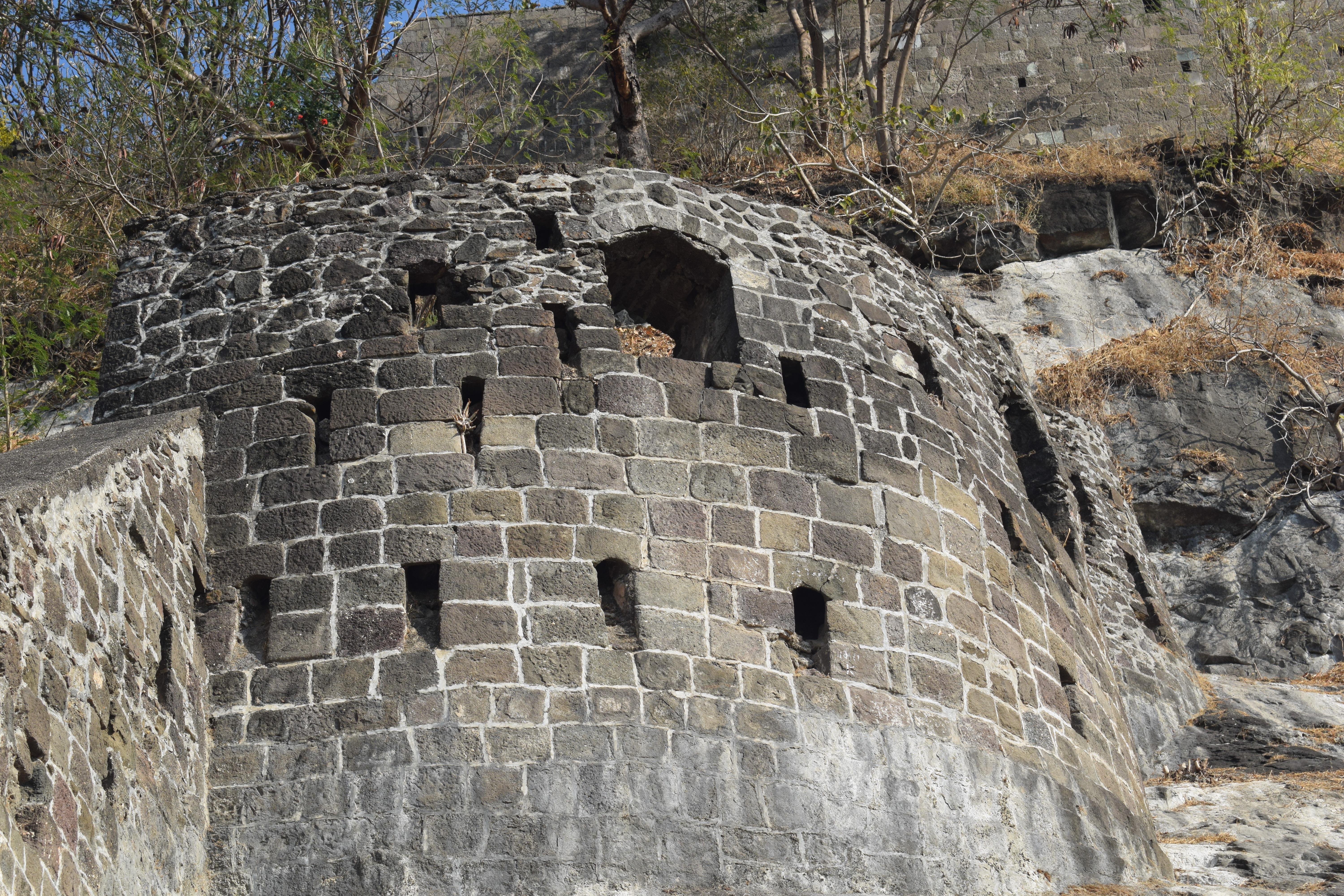
At each entrance, there are slit openings cut in stone walls above the door, used for pouring hot oil over the enemy. At Hathi Darwaza, there is a strategic double wall for a surprise attack. Behind each entrance door was a small place to rest in, known as devgarhi. The massive doors have iron spikes and I could imagine the pain they would bring to anyone who dared to go through forcibly.
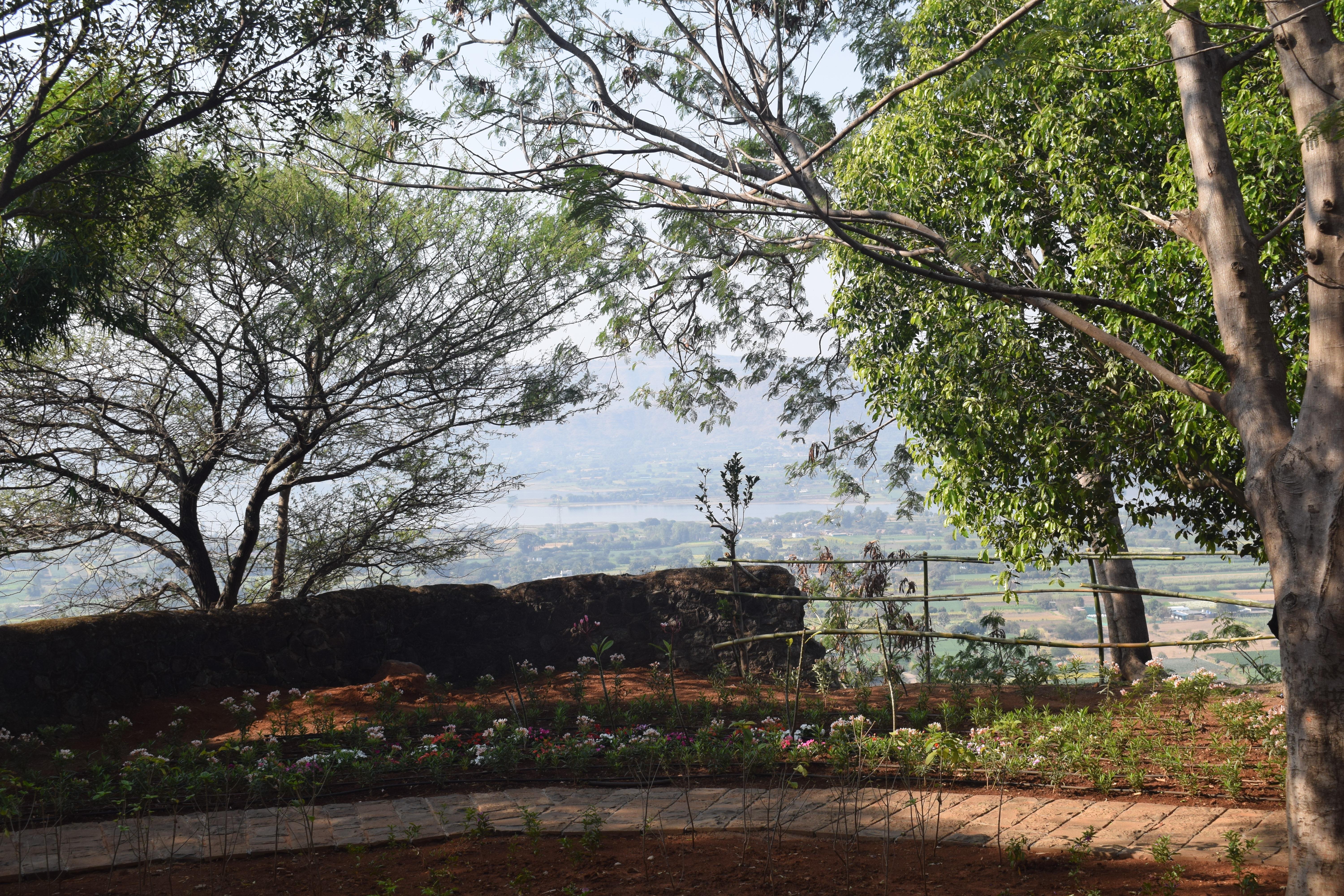
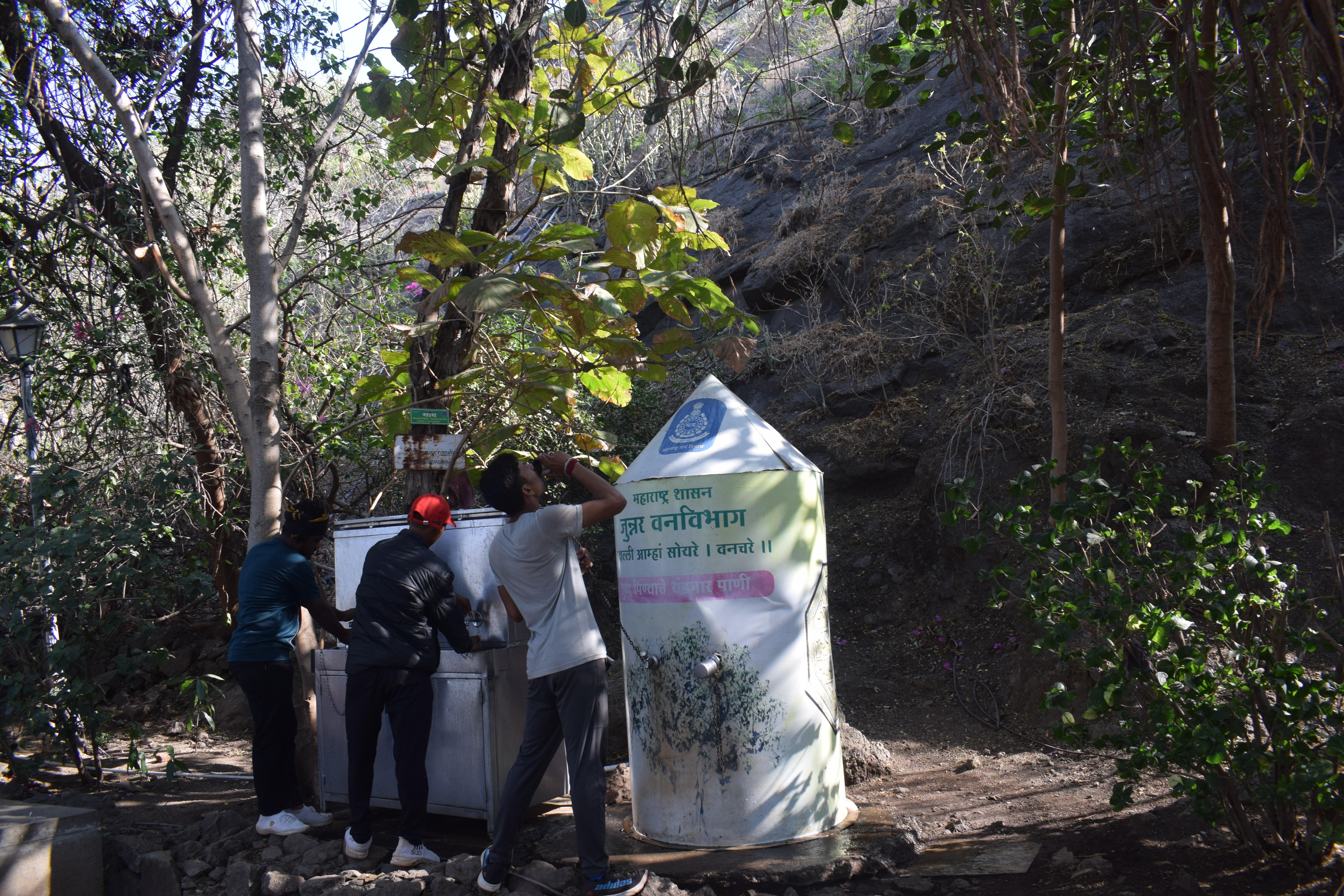
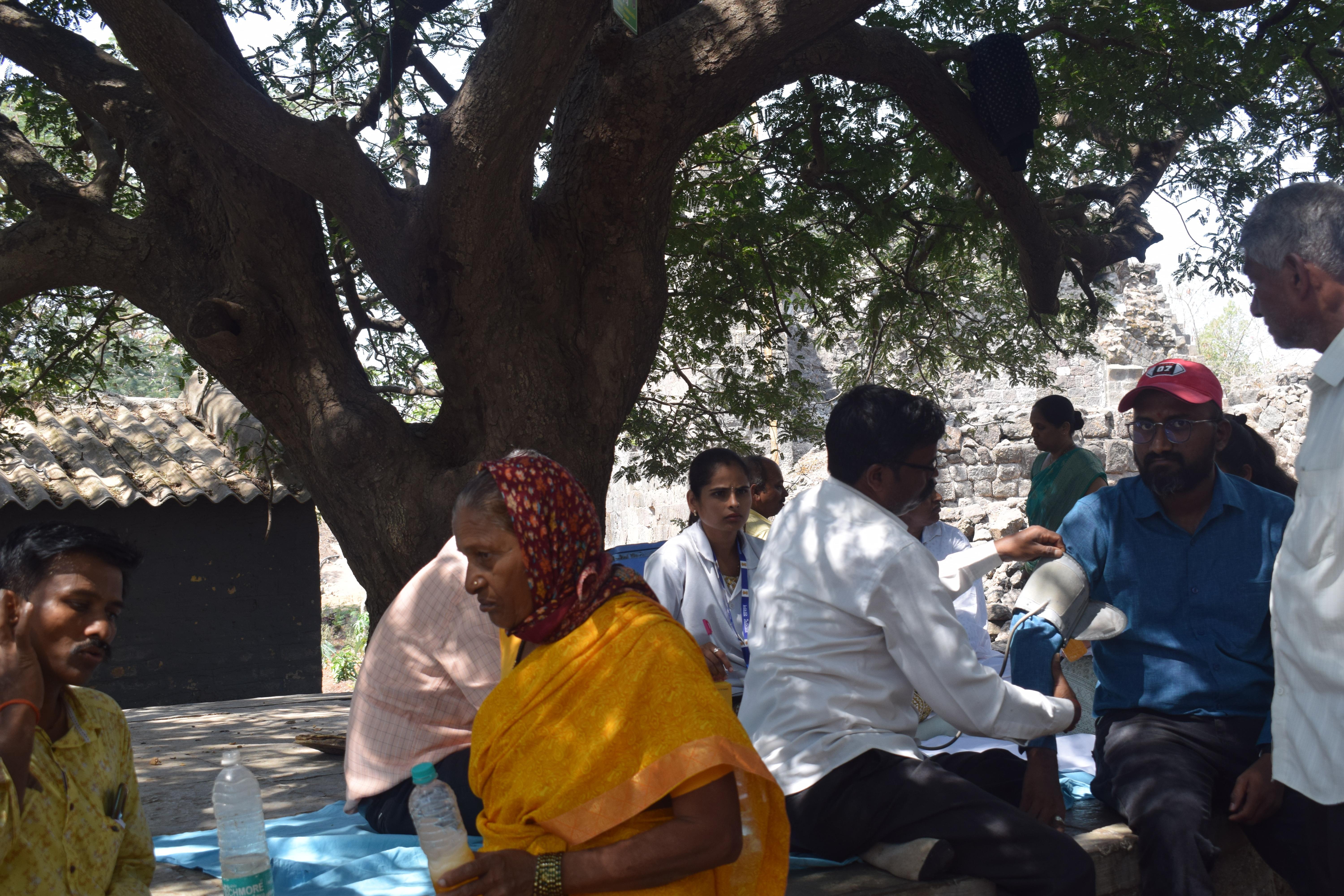
Along the way, we stopped often to catch our breath and capture the beauty of the Western Ghats. The fort has been restored by Archaeological Survey of India and there are beautified viewpoints. We admired the flora, the flowering trees, the shrubs, the cacti. There are water coolers every few metres and toilets as well. I even saw a health camp in progress.
The Buddhist caves, near the Shivai temple, were a wonder, filled with a large stupa and an ancient inscription that talks about Yavana or Greek traders. Then, paying obeisance to the guarding shakti, we climbed on.
The sun was climbing higher; as it grew stronger, we grew weaker. Fortunately, there are trees along the passage and resting points.
We cooled off inside Ambar Khana, the grain storage room. The grains were apparently poured from the roof and taken out from the door that we entered through. The high walls and narrow openings kept it fresh. There were many tunnels and secret doors inside the fort that Maratha soldiers took full advantage of to defeat their enemies.
It would have been nicer to have spent more time looking for the birds that I saw on the signboards along the climb up. The region has rich biodiversity.
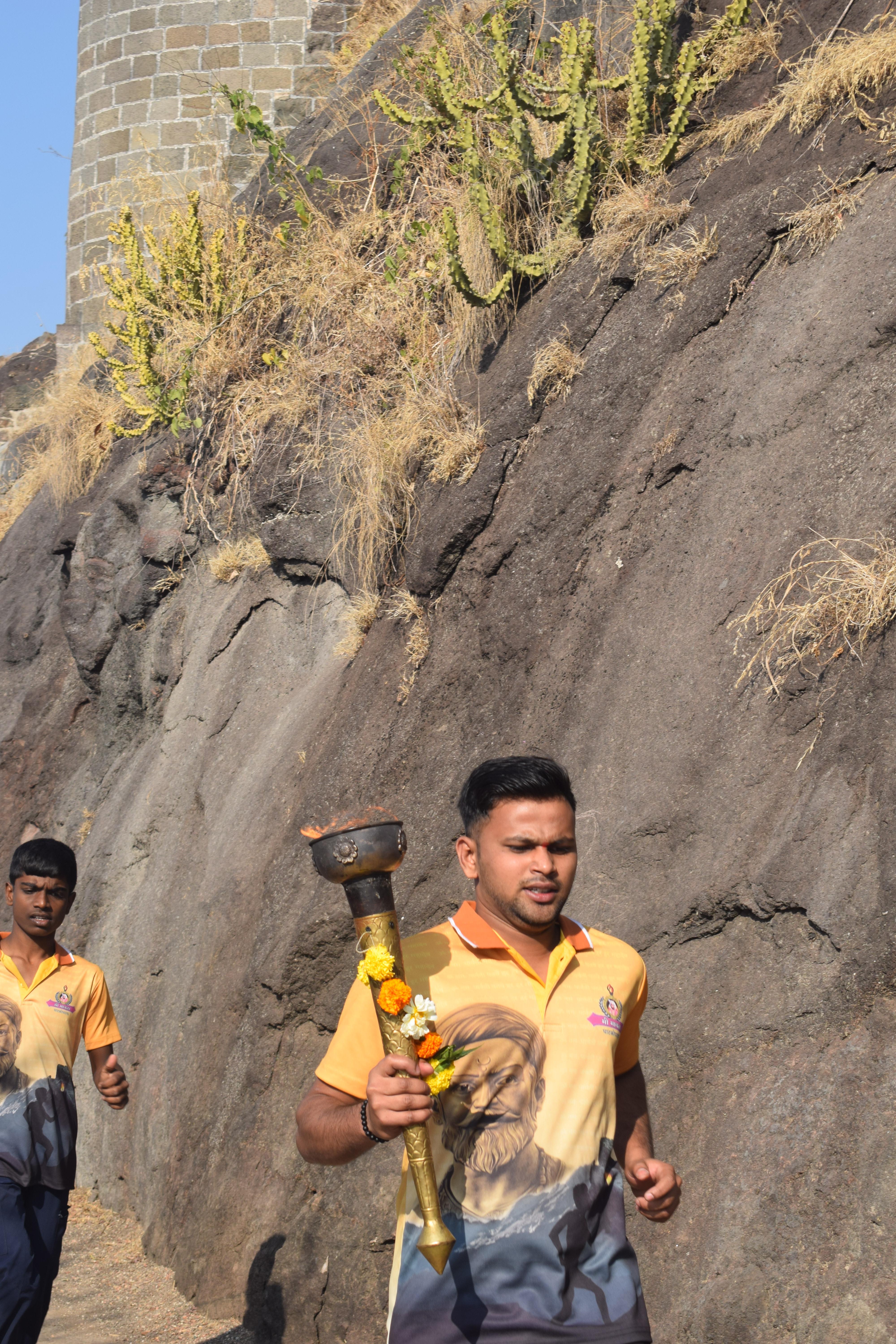
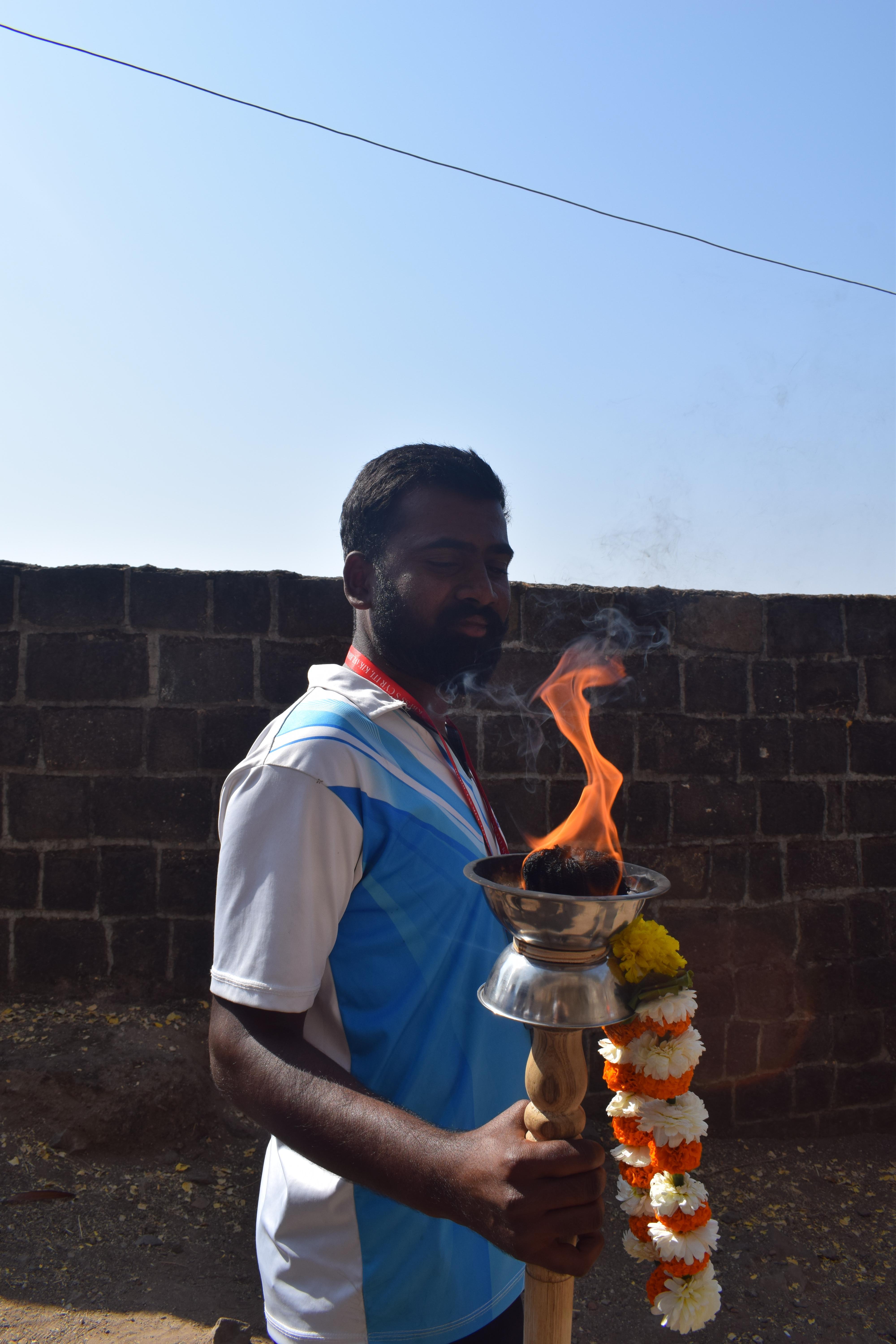
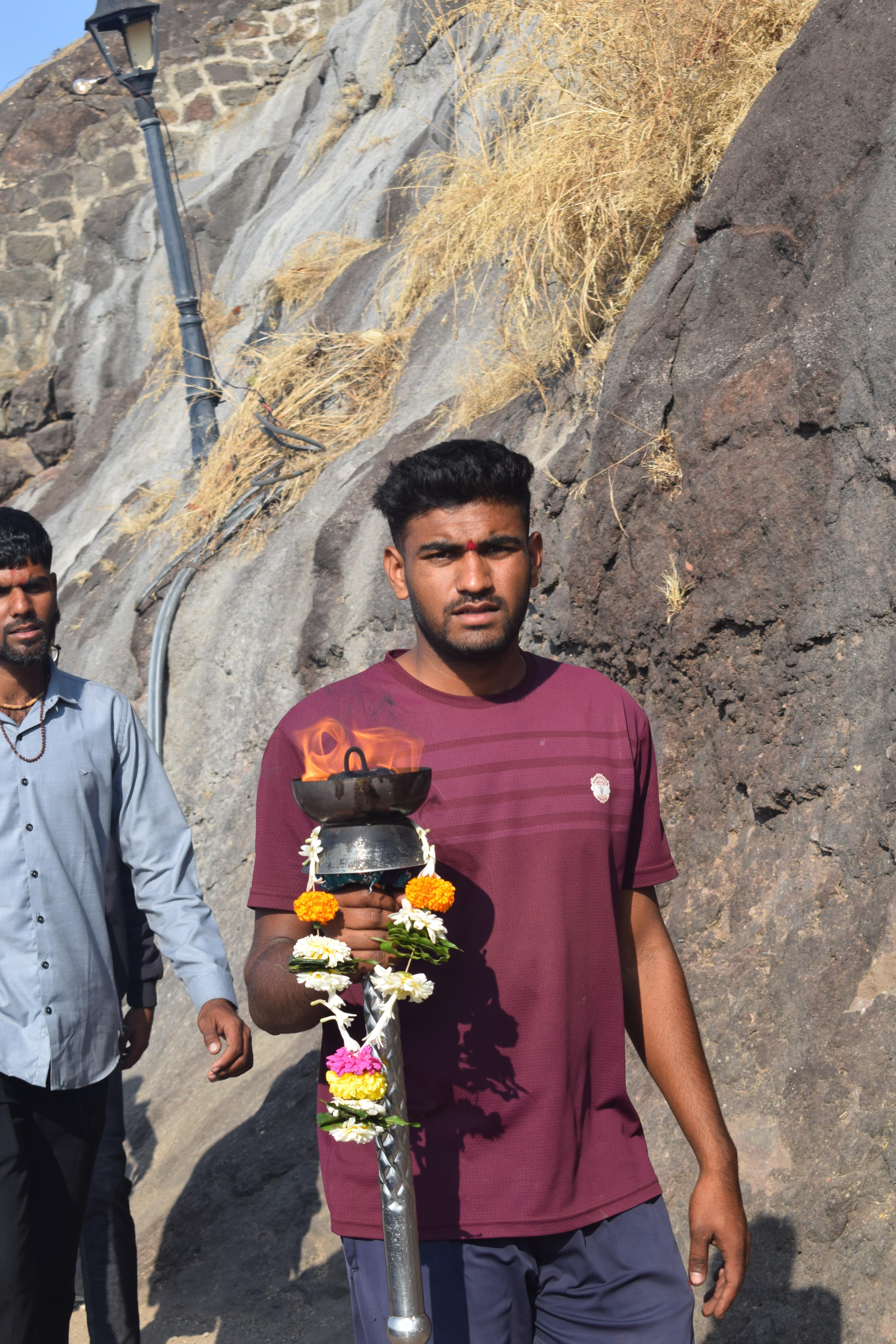
The high point of this festival was the torch that groups of young men carried in their hands. Many groups had come from all over Maharashtra with a torch, much like the one we see for the Olympics. As per tradition, they light the torch inside the emperor’s birthplace and run with this lit torch all the way home. It’s like a marathon; young boys on motorcycles accompany the torch bearer, cheering and chanting ‘Jai Bhavani, Jai Shivaji’ and ‘Har, Har Mahadev’. The warrior’s flames are embedded deep in their spirit.
A huge queue was at the entrance of the birthplace building, so we didn’t go in, but I believe there is a cradle and a picture of the ruler inside. The Badami Talao was also empty. We didn’t go to the Kadelot Kada as well, which is a precipice from where criminals and enemies were hurled down.

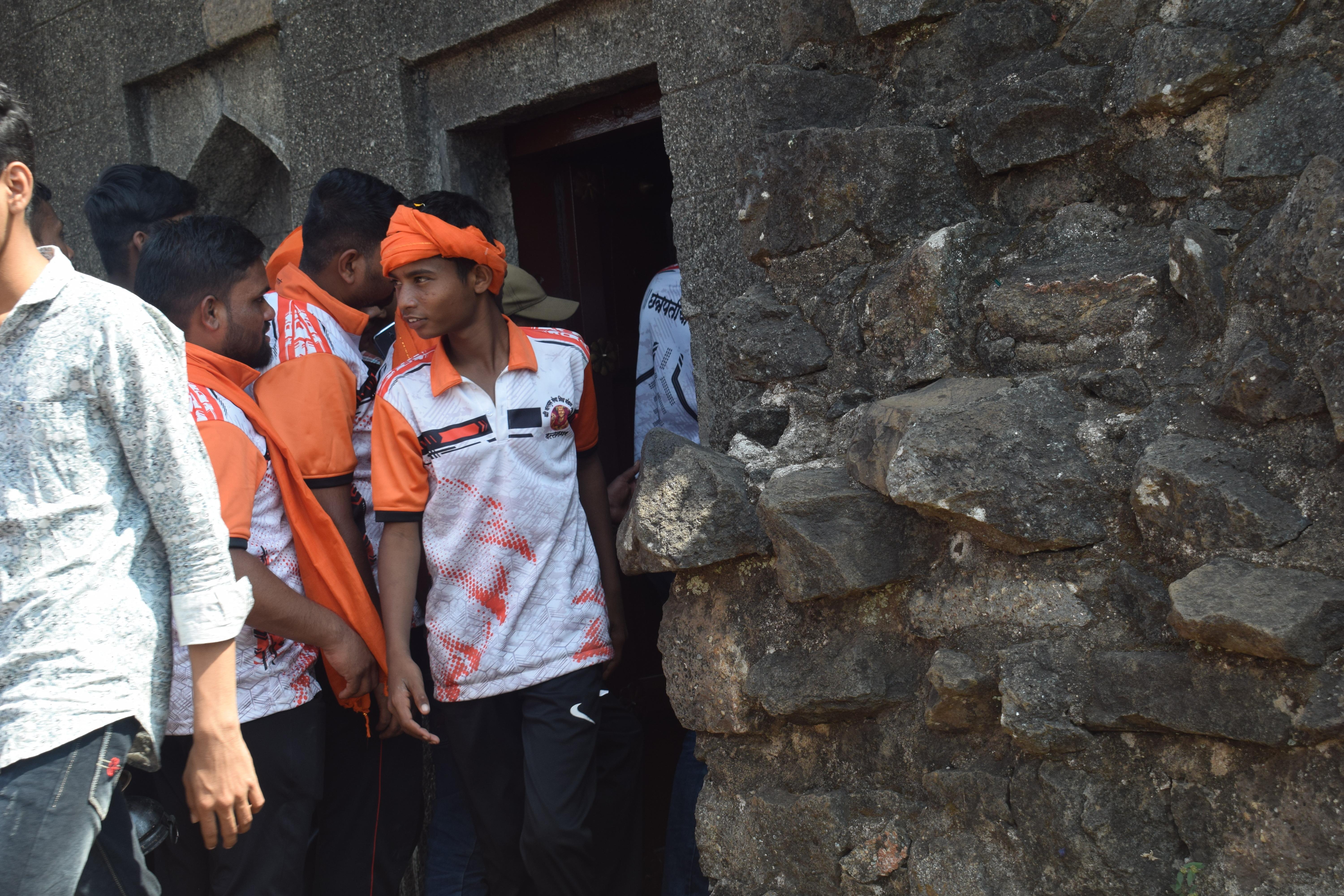
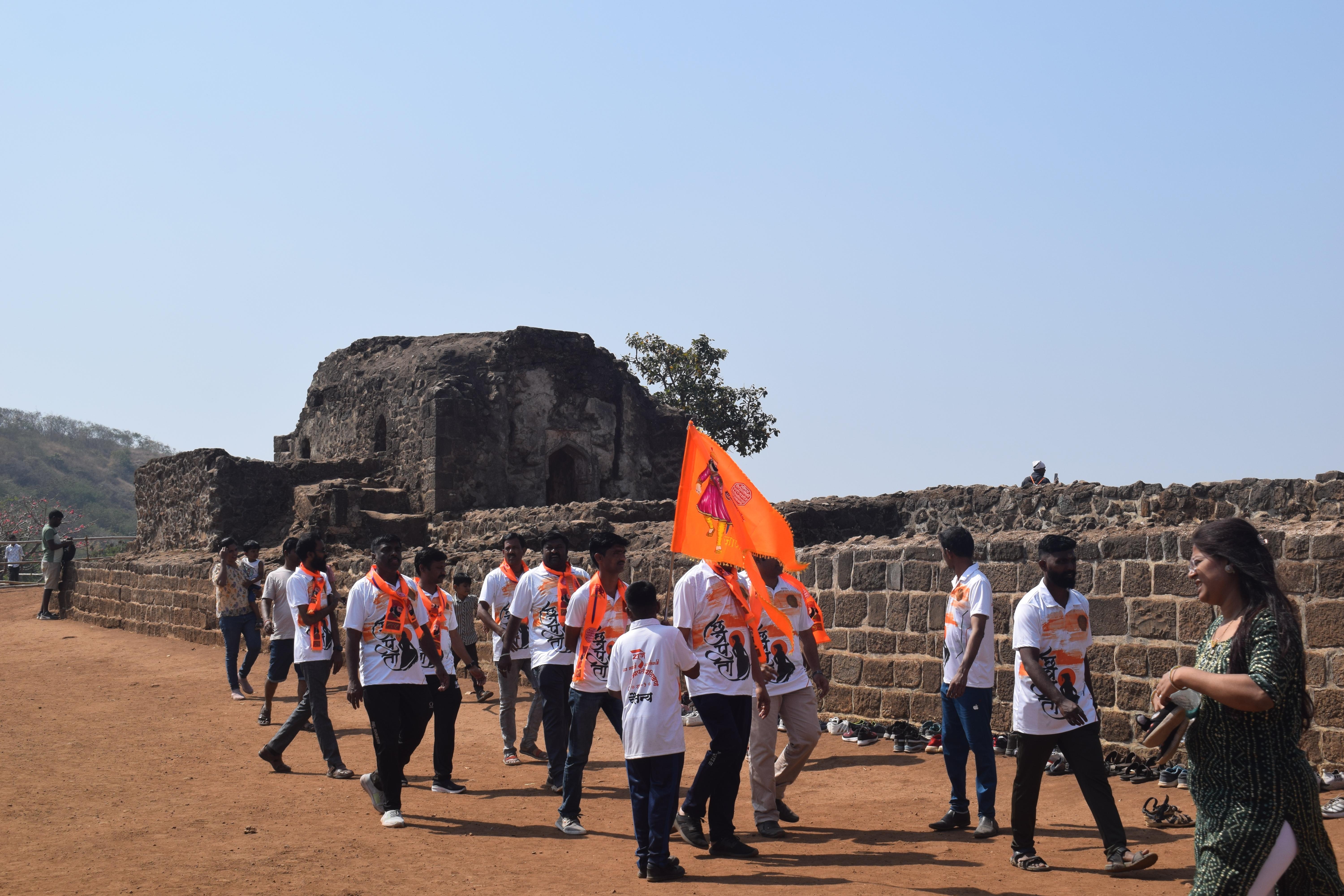
Standing on the flat hilltop, looking down on the land where everything seemed like a mere speck, and the vast sky above, it was almost like meeting the divine. The torches reminded me that spirit of the great warrior, who took his first breath here, was still watching over the land.
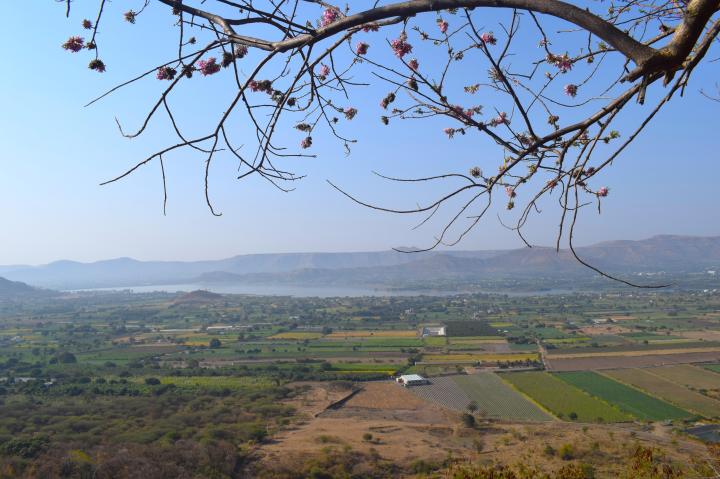
The walk down was quicker, but tiring for the knees. We came down in half the time and drank the much-needed glass of cool kokum sherbet before going back to the tent city for lunch.
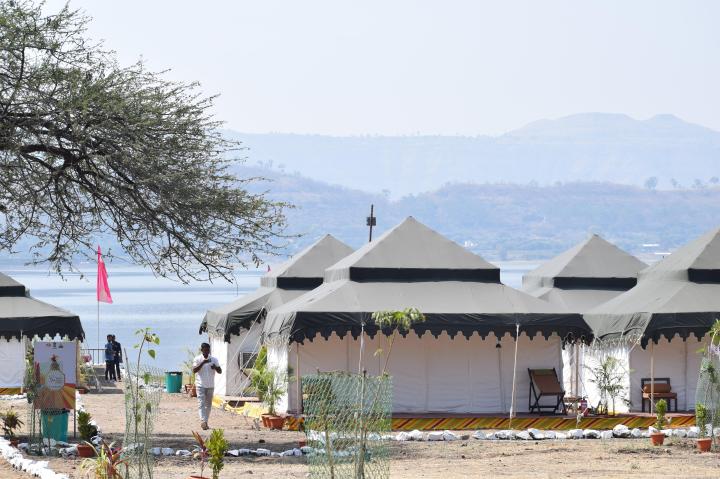
Things to keep in mind while hiking inside Shivneri Fort
1.The climb needs moderate fitness levels, as the ground varies between flat and uneven. There were some narrow turns and steps too.
2. Wear comfortable clothes and strong shoes. Do wear a cap or scarf, sunshades and a sunscreen.
3. You can carry your water bottle and keep filling it along the way.
4. Do carry your picnic basket and cameras as well. Also, get your garbage paper bag, so you don’t leave any litter behind.
5. It would be best to go with a guide, as you can enjoy the historical trail along with nature.
6. Start early in the morning if you want to enjoy the beauty.
7. I was told the views are even better during the monsoon.
8. There is another way up also, called chain route. So, you hold on to iron chain and climb up steps carved in the rocks. Too adventurous for me, I prefer the normally used one through Maha Darwaza.
9. The fort is closed after sunset. There is no entry fee.
10. To enjoy your hike and this heritage trail, keep the day free.
How to reach Shivneri Fort
Shivneri Fort is around 100 km from Pune. It is easily accessible by road.
This blog post is part of the blog challenge ‘Blogaberry Dazzle’ hosted by Cindy D’Silva and Noor Anand Chawla in collaboration with Mads’ Cookhouse.


Celebrating Chhatrapati Shivaji Maharaj’s birth anniversary in such a historic and scenic setting must have been an incredible journey, not just physically but also spiritually. It’s fascinating how these events bring history to life, allowing participants to walk in the footsteps of legends amidst the beauty of the Western Ghats.
LikeLiked by 1 person
Reading about your epic hike to Shivneri Fort felt like going on an adventure myself! The vivid descriptions of the surroundings and historical insights made me feel like I was right there with you, exploring every corner of this magnificent place. Thanks for sharing your wonderful experience!
LikeLiked by 1 person
Wow Ambica… what an enriching experience. To be honest, I didn’t know that Shivaji’s birth anniversary is celebrated with such fervor even today and people come from all over Maharashtra to be a oart of the festivities… thats amazing!
The place seems seeped in history and with the guide sharing insights and stories on its history, I can imagine how enjoyable it must have been.
P.S: you are doing wonders with your photography… Loved some shots… they look pro.😊
LikeLiked by 1 person
Yeah. Shivaji Maharaj is a God in the state. I was also surprised by the fervor.
LikeLike
Wow nice adventure. Yes walking uphill needs some fitness level. I have to work on my stamina because I may be fit but my stamina sucks.
LikeLiked by 1 person
This captures the spirit of Maharashtra and its rich history. The dedication to preserving and celebrating this legacy is truly inspiring.
LikeLiked by 1 person
You have given an in-depth story behind it. The hike seems hard and exciting. Shivaji is no doubt one of those forces that led India to where it is now.
LikeLiked by 1 person
Since childhood we have experiencing this. Very few times we went at Shivneri to celebrate the birth anniversary of Chatrapati Shivaji Maharaj. Your journey do look tiring but once you reach at top it is incredible. We had been through many forts. I will recommend you to do hiking to other forts too. Thrilling experience.
Love your details in the post with tips.
LikeLike
That’s very nice to know. You are a Maharashtrian then.
LikeLike
What a wonderful post. I live in Pune, but haven’t visited the fort during the birth anniversary of Shivaji. I will surely try visiting it at that time seeing your post as the experience sounds amazing.
LikeLiked by 1 person
I was lucky to get the invitation to celebrate Shivaji Maharaj’s birthday at Junnar. I fall for the place; it is absolutely amazing, and the Shivneri Fort is too good. But I only had very limited time to explore the fort in detail; maybe next time.
LikeLike
“As an Indian, I should be accustomed to the magnitude of celebrations across the country. But I wasn’t.”
Just goes on to show how culturally and traditionally rich a country we are, right? The chain route sounds adventurous for the thrill seeker in me, not sure I’d be willing to take the risk though but who knows? Thanks for sharing about this fort. I’m always eager to explore such historically rich sites which also have ample natural beauty to offer so I will be sure to add it to my travel list.
LikeLiked by 1 person
Wow, reading about your hike to Shivneri Fort in Junnar has left me in awe! It sounds like such an enriching experience, steeped in both natural beauty and historical significance. Your vivid descriptions paint a picture of the majestic Sahyadris and the rugged charm of the fort itself.
LikeLiked by 1 person
I loved revisiting history through your post on the Shivneri Fort and the adventures of Shivaji Maharaj, the epic Maratha King.I had gone to Pune many times, but because of some reason or the other, could never see this. At least your detailed post brought the fort to me. Also, the climb is not easy, kudos to you.
LikeLiked by 1 person
It’s amazing how these events make history feel real, letting people walk where legends walked. Thanks for sharing with us, because I had no idea that Shivaji’s birthday is celebrated with so much excitement even now, with people coming from all over Maharashtra to join the celebrations. I visited pune two time but nobody told me about this fort.
LikeLiked by 1 person
I love how the hike is not just about physical exertion but also about immersing oneself in nature and history. It’s a holistic experience that nourishes the body, mind, and soul.
LikeLiked by 1 person
First of all hats off to you for your energy and spirit to go for such an adventurous yet exhausting trail. Ask me , I will looknfor a medium which can drop me to the spot and I dont need to try hiking. I dont have that stamina or energy to go for it as my back pains badly and secondly I am not that much fond of Hills and mountains and sea and waterfront attracts me more. But I cant even ignore the rich history that you narrated in this post to explore. I can truly understand how thrilling and satisfying the hike was for you and I am glad you shared the same with us. Sharing is caring and you cared for each one of us and shared your experience with us. Thank you so much for enlightening us. Will love to read your travelogues more. Keep inking Ambica. More power to you.
LikeLiked by 1 person
Its like literally traveling to the place through your post and pics. Thanks for this guided, online tour. 🙂
LikeLike
I have always been fascinated by the history and yes ofcourse came across the Marathas history as well ..but never knew about this celebration… something new added to my source.Thanks for the post
LikeLiked by 1 person
Chhatrapati Shivaji Maharaj’s three-day cultural bonanza looks like a great show to explore the rich heritage and culture of Maharashtra. I have been to pune so many times but wasn’t aware about these places. Thanks for sharing this time will try visit shuvneri fort.
LikeLiked by 1 person
Been born and brought up in Aurangabad, now Sambhaji Nagar (named after Shivaji Maharaj’s son) I’ve grown up being revered by the bravery, justness and passion for Hindutva of Shivaji Maharaj. Have been to many forts till now but not Shivneri yet. I’m sure you had an amazing time! It’s quite an iconic place and you had the perfect backdrop and company.
LikeLiked by 1 person
I read about Sambhaji, killed brutally at 32. Heroes always have a different life. but they live on forever. I went to Aurangabad ages back, would like to go to the caves now when I have more knowledge of the region.
LikeLike
Quite a detailed and good description. You are right that our country is so diverse – and probably even a lifetime might be less to explore all that our country offers!! Haven’t really seen Maharashtra much but your posts are making a compelling argument to visit the state!
LikeLiked by 1 person
Loved the way you wrote about your experience. Standing on top of the mountain and realising we are also a speck of dust seems like a soulful experience to me.
LikeLiked by 1 person
I remember checking out your reel on the Shivneri Fort. As always, thanks for sharing a very detailed post about it. Would love to visit it. Have quite a bit of experience climbing up the Golconda Fort on multiple occasions although it was years back.
LikeLiked by 1 person
I would like to do.Golconda. checking it out now❤️
LikeLike
I virtually travelled along with you on this hike. The narrative made me imagine and so was the pictures. Id really love to visit this place of historic importance
LikeLiked by 1 person
I hope you do visit it. Am glad you enjoyed the virtual tour.
LikeLike
I admire the way you narrated the hike in such an engrossing and evocative manner. It literally gives goosebumps as if I am myself travelling this hike along. Loved it!
LikeLiked by 1 person
What a lovely experience! I had no idea about this fort, nor the celebrations. it is so heartwarming to see that people not only still remember, but also respect to this day.
LikeLike
Thank you so much for introducing us to these wonderful parts of India that we may never have otherwise learnt about.
LikeLiked by 1 person
Yeah..we never think about other regional parts ..which are so beautiful
LikeLiked by 1 person